


















PRESIDENT , Dr Irfaan Ali , in unveiling a new vision for the country, is urging citizens to embrace a service-oriented culture that prioritises their needs.

His plan calls for a shift in the mindset of those in the public and private sectors, whom he said must become more customer - focused and accountable in order to deliver high-quality services to citizens
By placing citizens at the centre of policymaking, the government hopes to create a more efficient and responsive public service This approach is expected to build trust and confidence in the government among citizens and to promote greater citizen engagement and participation in the democratic process.
Speaking at Saturday’ s opening of the US $5 million Sheriff General Hospital at Leonora, West Coast Demerara, President Ali said: “… we want to create a new service-oriented culture, one in which there is great dignity and pride in everything we do
“It is not for a show that will see members of the disciplined forces and cabinet on the ground in a clean-up exercise. It is to demonstrate that each of us, regardless of where we sit, we have an equal responsibility in the transformation in our thinking and the way we behave towards each other and the environment,” he said
The President said that the focus ought to be on efficiency, transparency, and accountability
He emphasised that the government must be more proactive in identifying and addressing the needs of citizens , rather than waiting for complaints and criticisms
“I urge all of us to engage in a renewal of thinking A renewal of purpose and a renewal of commitment towards our country and towards each other Investment and money cannot bring about
that renewal That renewal must come through a personal commitment Through personal change to advance back better interpersonal behaviours,” he said
President Ali also stressed the importance of collaboration between the government and the private sector, saying that partnerships are essential to achieving the goals of a service-oriented culture
He called on business leaders to work with the government to identify areas where private sector expertise could be leveraged to improve services and deliver better outcomes for citizens
“In ongoing works alone in Region Three, more than a billion US dollars is invested here in this region from the public and private sectors In ongoing projects from the public and private sec-
tors in this region, we collectively, as a country, are investing $200 billion Can you imagine a system that was institutionally designed to implement a $10 billion programme in maybe five years is now tasked with implementing a $200 billion programme in three years?
“This is the reality This is a circumstance that confronts us in this region and this is not the story of Region Three, this is not the story of Leonora; this is the story of every single region in this country Every community is being transformed at an unimaginable pace,” he said The President’s speech was met with enthusiasm from both government officials and business leaders, who praised his vision for a more service-oriented culture
The Head of State used the opportunity to call on all Guyanese to embrace the new service-oriented culture and work together to create a better future for the country
“People-centred development is crucial for our country Mind my words, not party - centred development , people-centred development That is what the People’s Progressive Party/Civic is about; people-centred development, putting people at the front, putting people at the centre and working from behind to advance those at the centre and those at the front,” he said
President Ali’s speech marks a significant shift in the government’s approach to service delivery and signals a new era of collaboration between the government and the private sector
With a renewed focus on efficiency, transparency, and accountability, Guyana is poised to become a leader in service delivery and a model for other countries in the region
Some ongoing developmental projects in Region Three include the $11.8 billion Schoonord-to-Crane four-lane highway which is expected to be completed before the end of the year
Additionally , the US $ 300 million Vreed-en-Hoop shore-base facility is expected to play a major role in transforming Region Three into a major player in Guyana’s oil-and-gas sector The project involves the development and utilisation of natural - gas resources for domestic power generation, as well as other industrial and commercial uses
Meanwhile, the $US 25 million Nismes wharf is intended to supplement the region’s development, including the gas - to - energy project at Wales , and will create significant opportunities for businesses and for Guyanese Ninety-nine per cent of the workforce will be locals, which signals enormous opportunities for the people of that region and by extension, all Guyanese.
‘APresident, Dr Irfaan Ali
THE $130 million state-ofthe-art Call and Business Centre for Persons with Disabilities (PWD) in Palmyra, Region Six (East Berbice-Corentyne), is nearing completion, President, Dr. Irfaan Ali, has disclosed.
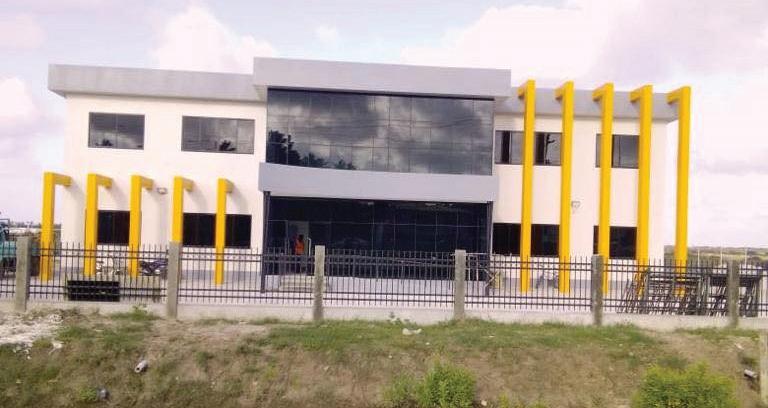
President Ali, in making the announcement on his official Facebook page, also shared snapshots of the ongoing works.
The initiative for the business centre came from First Lady Arya Ali, and upon completion, it will
facilitate the manufacturing of products, and offer retail space, technical training, and therapy for persons living with disabilities.
The centre will have five workstations for production, a boardroom, a therapy room, a cafeteria, and washroom facilities.
The commercial space's goal is to provide PWDs with a platform to market the goods they produce.
The Guyana National Bureau of Standards (GNBS) was approached to regulate and monitor the




facility's production, which will allow for the "Made in Guyana" certification to be applied to the products.
This certification will open up opportunities for the products to be marketed locally, regionally, and internationally.
The People’s Progressive Party Civic (PPP/C) Government has implemented several measures to assist persons with disabilities, including a $25,000 cash grant for training, equipment, hearing aid and other medical supplies, and entrepreneurial development.
The government has also provided public assistance to approximately 8,000 Guyanese living with disabilities, and every
The Call and Business Centre at Palmyra
child living with a permanent disability will receive a one-time cash grant of $100,000.
disabilities will benefit from public assistance, which will provide them with a combined disposable income of approximately $646 million to improve their livelihoods.
from the judges and those who swarmed the ground.
The organisers, Malcom Bourne and Hodhaih Lewi, told the Guyana Chronicle that the event was planned to showcase the diverse breeds of dogs to be found in Guyana.
and Claws spoke with this publication, and she shared that the pet shop is exclusively for dog and cat owners.
DOGS of all sizes and breeds and their owners on Sunday gathered at the Saint Stanislaus Ground on Carifesta Avenue for Dog Expo 2023, where a number of prizes
were up for grabs, and “doggie” essentials and accessories were on sale.

The event, which was organised by Olympus Kennel, was promoted as a fami -


ly-oriented affair where dog owners could display their pets.
Many of the dogs in attendance were dressed in adorable outfits, which attracted positive comments
Given the huge interest it has generated, and the fact that there are dog lovers all across Guyana, they said that holding a similar event outside of Georgetown is being considered.

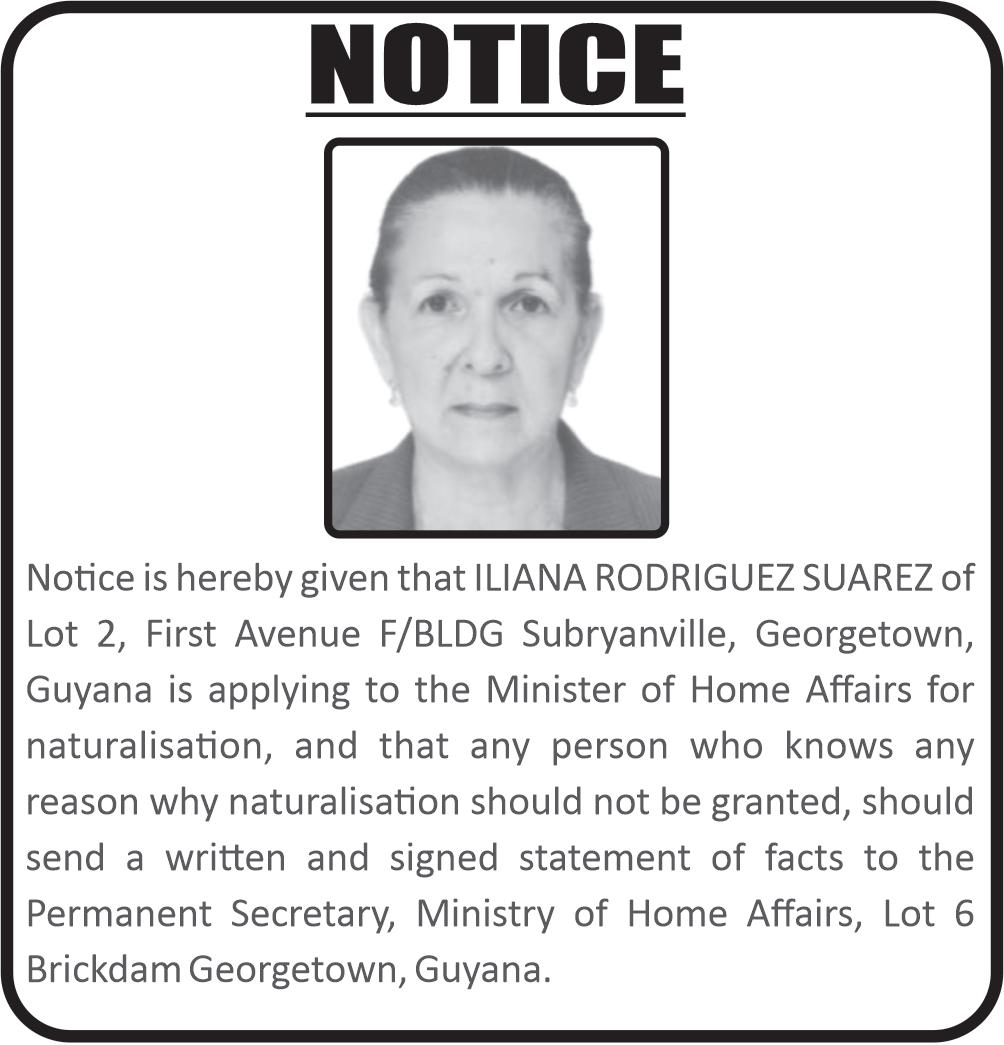

The dog ‘expo’ was planned with dog owners and dog lovers in mind, and featured multiple breeds of dogs, among them: Rottweilers; German Shepherds; American Bullies, Huskies and American Pitbull Terriers.
More than 50 dogs were registered to compete in the best-dressed, best groomed, most obedient, smallest and largest, and best conditioned categories.
Additionally, pet shop and grooming spa, Paws and Claws had eye-catching items on display. Many visited the booth, and made purchases for their dogs.
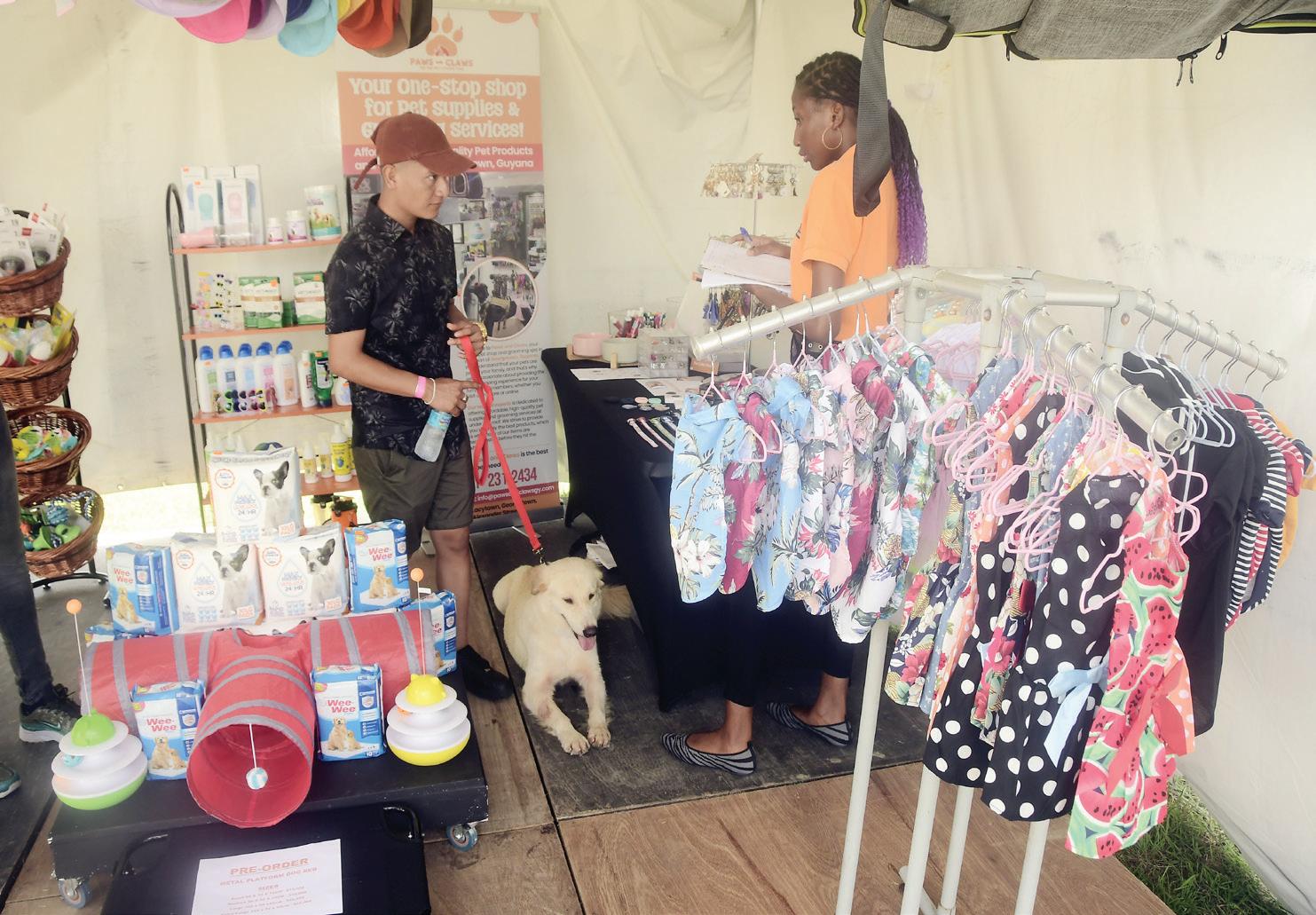
Travell Blackman, a representative of Paws
The pet store offers a wide array of pet clothing, toys, trinkets, pet carriers, collars and much more to cater for your pets needs.
This year’s dog
show was sponsored by a number of companies including Trophy Stall, Sheriff Security and the Outdoor Pet Store.(Faith Greene)
THE launch of the Political Affairs Committee (PAC) in 1946 by Dr Cheddi Jagan, his wife Janet, Ashton Chase and others, led to the beginnings of the political alliance in working-class interests that resulted in the launch of the People’s Progressive Party (PPP) on January 1, 1950.
Like the PPP, many other ‘Labour’ parties also formed by the trade unions following 1938, to contest the first rounds of ‘Adult Suffrage’ (right to vote) in the British Crown Colonies in 1951. Most of the Labour Parties won the first elections across the West Indies and eventually established the West Indies Labour Party, that sought to coordinate the political and electoral activities in office, to ensure they delivered what the trade unions were demanding before and after 1938.

The PPP, which united the progressive trade unions,
African and Indian workers and all Guyanese citizens in pursuit of ending colonial domination, won all the general elections after Adult Suffrage (the right to vote), including in 1964 when an externally-engineered split robbed the PPP of its earned victory.
That split divided the people, workers and trade unions along race and party lines, weakening trade unions’ effectiveness and cheating the PPP out of office for 28 years, during which deteriorated working conditions, low wages and higher salaries led to trade union militancy strong enough to unite unions against political suppression of the Guyanese working class in the name of building ‘Co-operative Socialism.’
Since the return of democracy in 1992, trade unions have regained their full legitimacy and the revival of the nation’s economic
fortunes has also brought an increase in production and earnings possibilities that will make it easier for public and private sector enterprises – and the government -- to pay workers even better.
Fate has treated the Guyanese working class very well, with the pro-worker PPP-Civic administration in charge of the national purse strings at the right time and able to influence the legislative and other changes that will make it easier for trade unions to gain more and better benefits for workers generally.
There’s no getting away from the fact that especially since August 2020, employers and workers’ organisations are all praising the current administration led by President, Dr Irfaan Ali, and the People’s Progressive Party (PPP) led by General Secretary Dr Bharrat Jagdeo.

Despite the political theatrics of their representative
union’s leadership, government employees also have high hopes for escalated wage increases and more improvement of working conditions.
But the rebuilding of Guyana and the continuing investments in energy and continuous discovery of oil and gas, as well as the provisions of the Local Content Act, together ensure more employment for new workers and more choices for those with traditional and modern skills.
The general economic situation continues to improve year by year, month by month and day by day, as the PPP/C administration continues to properly husband the nation’s resources and earnings in ways that improve the lot of all workers and families through national and community projects that touch everyone, everywhere. Fortunately, younger elements with broader minds
in the trade unions and opposition political parties, just like in the private sector leadership, are increasingly joining and embracing the government’s invitations to local and foreign companies to invest more, with more incentives, which will also ensure they can easier pay better wages.
May 1, 2023 is seeing unprecedented levels of industrial action across the UK, as doctors and nurses, emergency health staff, train and transport, immigration and other government employees in essential service sectors stage unprecedented strikes in areas like nursing.
In Guyana, however, the superior management of the economy and the nation’s finances by the current administration has shown that, 85 years after the 1938 Caribbean working class revolutions, 77 years after the PAC was established, 73 years after the PPP was launched and 72
years after Guyanese first got the right to vote and chose the PPP first and with the June 2023 Local Government Elections (LGE) approaching, it’s even clearer than ever before, that Guyanese workers and their families, on both sides of the political spectrum and all sides of the ethnic and racial divides, the public and private sectors, trade unions and other entities representing ordinary working people, are again rallying behind the first and original party formed with the interests of the nation’s working class at heart. And that’s only natural because it’s an established fact – supported by history and by the figures and testimonies being seen and heard increasingly today -- that the Guyanese working class, like all citizens, do feel and live better under PPP/C administrations.
Dear Editor, PRESIDENT Ali is commended for pursuing closer economic ties with India. Guyana historically has benefitted from India's generosity and kindness in spite of our country's cold shoulder towards India by succeeding governments.
The Irfaan Ali government has “wised up” and opted to pursue closer economic relations with India, resulting in several economic delegations visiting Guyana and signing memoranda of agreements in various areas. The President and VicePresident also visited India in separate trips, bolstering economic and political relations. The Foreign Minister (MEA) Dr S Jaishankar also visited Guyana last week to strengthen relations. He is
one of the most talked about Foreign Ministers of any country by experts in Washington, where he served as Ambassador some years ago.
Dr Jaishankar has been highly rated by intellectuals in international relations.
Jaishankar, a scholar in international relations and an expert on Russia, China, USA, and Japan, has been conducting India's foreign policy with great finesse. His diplomacy has resulted in positive benefits to the Indian economy. He has been travelling the globe to pursue economic tie-ups between India and other countries.
So, it is no accident that he has visited Guyana and held round-table business discussions with captains of industry.
A Guyana-India Chamber
of Commerce was launched in Georgetown. The MEA Dr Jaishankar announced that there will be annual India-Guyana-CARICOM business summits from next year, alternating between India and the Caribbean. Guyana and the region stand to benefit enormously from economic ties with India which is the fastest-growing major economy that is set to become number three in GDP by the end of this decade. Currently, India is number six, just nipping the UK last year. Western economies, Japan, Australia and New Zealand are courting India for closer trade and political (security) ties.
The state of the Indian economy and western security has been a major talking point today. India has
managed its economy well. While other major economies are on the brink of a recession, India has been growing. The economy contracted in 2020 because of COVID, but has bounced back over the last two years, recovering to pre-COVID level in terms of output. Unlike in other countries, inflation is relatively low in India. The Reserve Bank of India has done a great job in managing monetary policy. Interest rates were raised judiciously as in the USA, putting a handle on inflation.
But unlike in the USA where the economy has stalled, India's economy has grown. Foreign exchange reserves were released strategically in India, buying and selling dollars to prevent the rupee exchange rate from wide fluc-
tuations. Westerners see opportunities in India which has a stable economy and huge foreign exchange reserves.
As the war in Ukraine continues and hostility deepened in relations between the west, Australia, Japan and China, major Western companies are now looking at India as a potential investment destination. This will provide greater economic opportunities for India and increased trading between Guyana and India. It can also potentially lead to Indian companies investing in Guyana, especially in food production, to meet Western demands.
Guyana can be an attraction to Indian investors in oil and gas, energy, agriculture, and education. It is important, therefore, that Guyana deepens ties with India. Greater
benefits will follow.
It is recalled that Guyana and the Caribbean have benefitted tremendously from India's aid programme over the last 65 years. India doled out thousands of scholarships to students in the region valued hundreds of millions in American dollars, as well as billions more of American dollars in non-repayable grants, soft loans, vaccines, technical assistance, training, and other forms of aid to Guyana and the region.
Guyana can further benefit from India’s progress and expertise in the fields of science, engineering, data and economic strategy to consolidate Guyana’s path to development.
Yours truly, Dr
Vishnu Bisram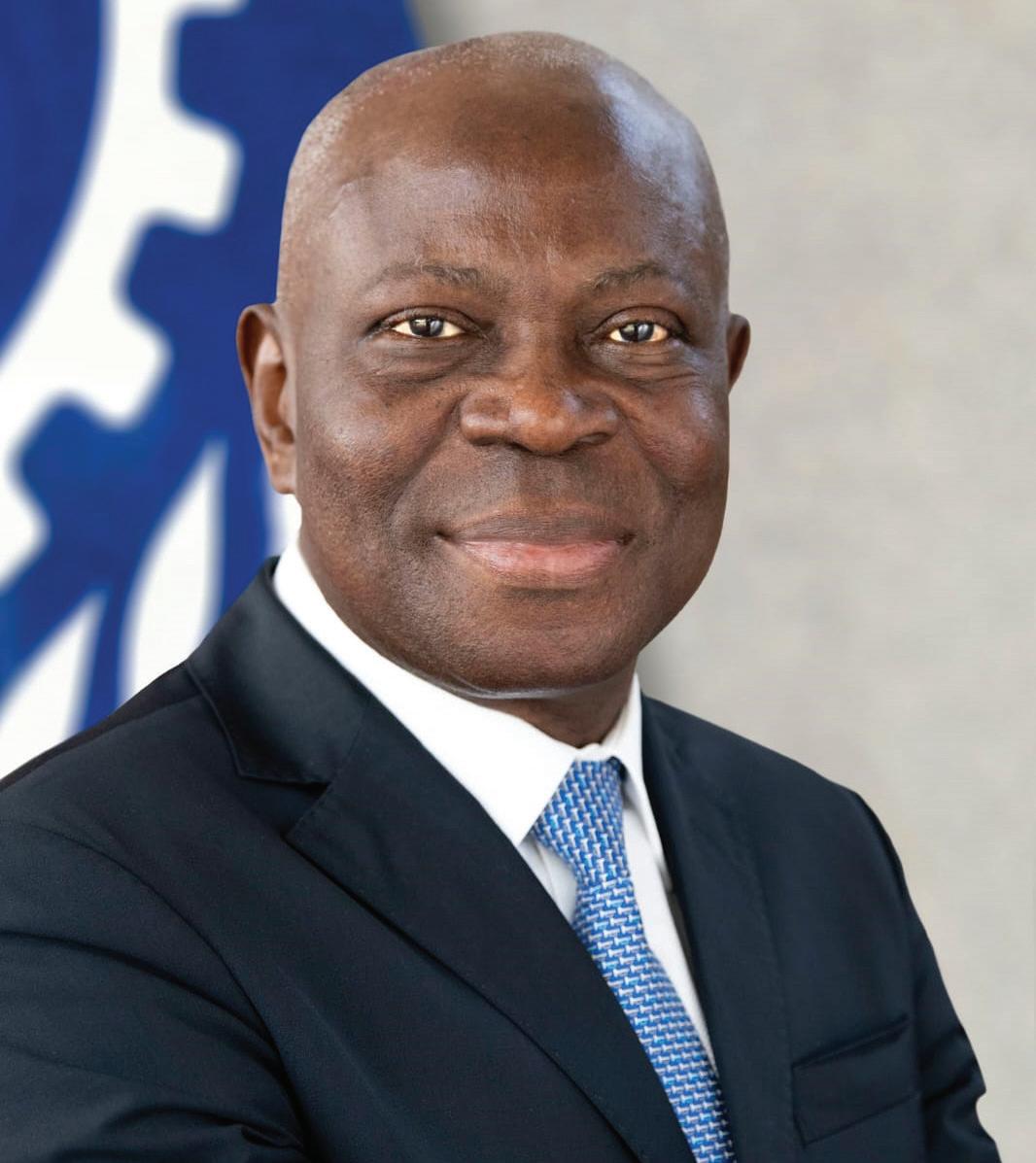
MAY 1 is widely known as Labour Day, a day when we celebrate the contribution of workers worldwide. It is a moment for pride, celebration and hope.
After three years of the COVID-19 crisis, followed by inflation, conflict, and food and fuel supply shocks, we badly need this. But the promises of renewal made during the pandemic, of ‘building back better’, have so far not been delivered for the great majority of workers worldwide.
Globally, real wages have fallen, poverty is rising, inequality seems more entrenched than ever.
Enterprises have been hard hit. Many could not cope with the cumulative effects of recent unexpected events. Small and micro-enterprises were particularly affected, and many have ceased oper-
ations.
People feel that the sacrifices they made to get through COVID-19 have not been recognised, let alone rewarded. Their voices are not being heard clearly enough. This, combined with a perceived lack of opportunities, has created a disturbing level of mistrust.
It doesn’t have to be like this. We are still the masters of our fate. But if we are to shape
a new, more stable, and equitable world, we must choose a different path. One that prioritises social justice.
I believe this is not only do-able but essential for a sustainable and stable future. So, how do we get there?
First and foremost, our policies and actions must be human-centred, to allow people to pursue both their material well-being and their spir-
itual development in conditions of freedom and dignity, economic security and equal opportunity. This approach is not new, it was set out and agreed in the aftermath of World War Two, when the ILO’s international membership signed the 1944 Declaration of Philadelphia.
This visionary document set out guiding principles for our economic and social systems, that they should not be turned exclusively to hitting specific growth rates or other statistical targets, but to address human needs and aspirations. This means focusing on inequality, poverty alleviation and core social protection. The most effective way to do this is by providing quality jobs so that people can support themselves and build their own futures – ‘Decent Work for All’, as Sustainable Development Goal 8 terms it.
It means realistically addressing the long-term structural transformations of our time; ensuring that new technology creates
and supports employment; pro-actively facing the challenges of climate change and ensuring we offer the jobs, skills training and transition support necessary for workers and businesses to benefit from the new low-carbon era; treating demographic changes as a ‘dividend’ rather than a problem, with supporting action on skills, migration and social protection, to create more cohesive and resilient societies.
We also need to reassess and refashion the architecture of our social and economic systems, so that they support this change of course towards social justice, rather than continuing to channel us into a policy ‘doom loop’ of inequality and instability. We must reinvigorate labour institutions and organizations so that social dialogue is effective and vigorous. We must review laws and regulations affecting the world of work, so that they are relevant and up-to-date and able to protect workers and support sustainable
businesses.
To make all this happen, we need to recommit to international co-operation and solidarity. We must enhance our efforts and create greater policy coherence, particularly within the multilateral system, as the United Nations Secretary-General, Antonio Guterres calls it.
This is why we need a Global Coalition for Social Justice. This Coalition will create a platform to bring together a broad range of international bodies and stakeholders. It will position social justice as the keystone of the global recovery, so that it is prioritised in national, regional and global policies and actions. In sum, it will ensure that our future is human-centred.
We have the chance to reshape the world we live in – economically, socially and environmentally. Let us take this opportunity and move forward to build the equitable and resilient societies that can underpin lasting peace and social justice.
Dear Editor, REFERENCE is made to a letter that was published in the Kaieteur News edition of April 28, 2023, by former General Manager of the Guyana Co-operative Agricultural and Industrial Development Bank (GAIBANK), Professor Dr Kenrick Hunte. The professor sought to address ExxonMobil’s first-quarter oil report wherein he contended that the information released by the Bank of Guyana (BoG) “is no better than a publicity stunt that obviates any standard associated with complete transparency.” The professor further asserts that “we have not learnt anything from our history. In particular, it appears that we have replaced the Sugar
Barons with Oil Barons… Is history repeating itself as more oil is found?”
In response to the aforementioned, arguably unjustified postulations by the professor--and since he argued whether history is repeating itself -- this author sought to examine the professor’s own track record at a time in our history when he presided as the General Manager of GAIBANK.
Of note, the professor’s track record regarding transparency is also examined in terms of management of the entity and reporting. The evidence will show herein that it is ironic that the professor’s own track record in this respect leaves much to be desired, because there was a lack of transparency and accountability of the failed
institution, and mismanagement, inter alia, poor lending decisions.
In one of his letters a few years ago, Professor Hunte had disclosed that he was employed at GAIBANK from 1980-1993 in various technical positions before advancing to General Manager in 1985–1993. The economist was responding to someone at the time who accused him of mismanagement of the said institution under his tenure, which largely led to it having to be liquidated. He then sought to deny this allegation and absolve himself of any mismanagement of the institution and claimed that if the government had implemented the Auditor General’s (AG) recommendation at the time in relation to for-
eign exchange losses that he claimed was a government liability, then the true profit of the entity would have been reflected.
In this regard, he cited the AG’s recommendation which stated that it was proposed by the AG to invoke the laws of Guyana to deal with the foreign exchange losses, section 50 (2) of the Co-operative Financial Institutions Act, Chapter 75:01. He claimed how the PPP government ignored the advice of the AG. However, a perusal of the referenced section of the Act states that:
“If the reserve fund is in any given year insufficient to cover any net loss of the financial institution recorded in its Profit and Loss Account, an amount equivalent to the deficiency is hereby
charged on the Consolidated Fund.”
It would appear, nonetheless, that the former General Manager of GAIBANK was not entirely truthful in his missive, because a perusal of the 2001 Bank of Guyana Annual Report, Table 5-V contained a statement of asset and liabilities of GAIBANK. In contradiction to his claims, the table showed that as of June 1991, the accumulated deficit of GAIBANK was $397.6 million, which was cleared, resulting in a surplus position of $23.5 million by December 1991, and remained in a surplus position of $2 billion as of May 1995. There is another column in the table that showed government contributions on the liability side of the statement which could
only mean that the deficit balance was cleared by way of a charge on the Consolidated Fund.
Importantly, it should be mentioned that when the professor argued that the foreign exchange loss is a government liability, the implied interpretation by a non-technical person is such that, one may tend to believe that the liability is unrelated to the operations of GAIBANK. And therefore, it should not have been reported on GAIBANK’s balance sheet. However, this is not the case. Indeed, the government was the sole shareholder of the entity, but the foreign exchange gains or losses are directly related to the normal operations of the bank. Hence, it is correctly
ANTHONY Gordon, a 13-year-old student of Wismar/Christianburg Secondary School, allegedly drowned around 13:00 hours on Sunday at 'Buck Town' Creek in Wismar, Linden, according to the police.

Gordon, who resided at Lot 281 One Mile Wismar, Linden, with his mother, Keisha Daenty, was in
the company of two friends, aged 10 and 14, and they were all swimming together when tragedy struck.
According to a police statement, Gordon reportedly “ran into the water” and was submerged for some time before his friends noticed he was missing and raised an alarm.
“Some residents came out and searched the entire area. Gor-
don's body was later discovered at the bottom of the creek in a motionless state. The body was then fished out from the creek and escorted to the Linden Hospital Complex, where he was pronounced dead on arrival at 15:58 hours by Dr. Ross,” the statement added.
The body was examined, but no marks of violence were seen.
It was later escorted to the G-Jetsco Mortuary to await a post-mortem examination.
Commander for Regional Police Division #10, Senior Superintendent Hugh Winter, Divisional Detective Inspector Komal Pitama, Chief Inspector Lyte, and other ranks visited the scene at about 15:30 hours on Sunday.
FROM PAGE 7
reflected on the entity’s balance sheet.
The core business of the development bank was lending and therefore, the true performance of the institution under Hunte’s tenure would have been reflected in the quality of the loan portfolio and not the foreign exchange gains/losses. In this respect, it must be highlighted that in the former General Manager’s letter of December 2009, he was careful to stay completely away from speaking to the portfolio’s performance under his tenure.
With that in mind, this author has managed to secure copies of the annual reports for GAIBANK for the period 1983-1987. Having examined these reports, there were some interesting findings worth mentioning.
To this end, in the 1983 Annual Report, the former General Manager, Kenrick Hunte, reported that “the bank performed creditably, recording the highest values ever in the levels of disbursement amounting to $29.4m, and repayments $21.7m, as well as 5275 processed and 3821 approved applications valued at $38m. At the end of 1983, total assets stood at $90.3m, outstanding loan portfolio of $70.5m, and government equity contributions valued at $55m.”
Interestingly, what he did not report on was what portion of the loan portfolio was considered bad debt to be written off and/or contaminated.
Some of the findings of the AG as reported in GAIBANK’s 1983 Annual Report were stated as follows:
Interest on loans$8,126,966: This figure may
be affected as a result of the observation at paragraph 11 below.
Investment income - $216,753: This amount is understated by $166,939 representing interest not brought into account in respect of fixed deposits totaling $2,886,872.
Rent - $155,884: This figure does not agree with the amount $329,764 shown in the rent-receivable register.
Chain Saw Income - $489,990: This amount is overstated by an undetermined amount as it includes the cost of the chainsaw sold.
Interest and credit fees - $1,571,527: This amount is understated by an undetermined amount due as interest for 1983 which was not raised in the accounts in respect of an International Development Association Loan.
Gain (Loss) foreign exchange transactions - $1,269,279: This figure is overstated by $112,465 on sterling disbursements.
Deficit at the end of the year - $5,405,483: This figure would be affected in view of the above-mentioned.
Interest receivable$10,402,288: The total of the balances on the customers’ loan accounts exceeds the balance of $10,402,288 by $464,773.
Investment$7,250,042: The balance is more than the balance confirmed by the Guyana National Co-operative Bank by $275,001.
Stock - $750,063: This figure has not been verified as schedules supporting this balance were not submitted for audit. Customers -
$82,517,105: The total of the balances on the customers’ loan accounts is less than the balance of $82,517,105 shown in the general ledger by $1,763,368.
Interest and credit fees payable - $2,324,710: This amount would be understated as a result of the above-mentioned observations.
A statement of analysis of the loan portfolio has not been produced for the audit.
Certain aspects of the internal control system were unsatisfactory and the quality of the accounting records and administrative procedures, including supervision, were inadequate
Provision for bad and doubtful debts$380,512: this provision would appear to be inadequate in view of the fact that $6,293,730 representing approximately 83% of the total loan portfolio is contaminated with overdue interest and principal amounting to $579,933 and $1,663,438 respectively, shown on the lost schedules submitted. This was in respect of a sub-programme loan agreement between the government and the Inter-American Development Bank (IDB)
It was also found that though the value of the loan portfolio grew from $67.9 million in FY 1983 to $280.3 million by the end of FY 1987, representing a cumulative growth of 306 per cent the number of applicants (business entities or individual borrowers) declined dramatically from 5,275 in FY 1983 to 1,689 by FY 1987. In other words, lesser and lesser persons benefited
from loans under Hunte’s tenure as General Manager, while fewer persons benefitted in larger sums. Obviously, this suggests that the risk profile of the loan portfolio increased substantially by virtue of advancing significantly larger-value loans to fewer persons, rather than spreading the risk to cover an increased number of borrowers.
That aside, the accumulated deficit grew from a position of $5.4 million in FY 1983 to $91.2 million by the end of FY 1987. Of this sum, 89 per cent or $81 million accounted for accumulated foreign exchange losses. This level of foreign exchange loss was on account of the depreciation of the exchange rate from $4.25 in 1985 to $9.7 by 1987 and a further devaluation to $39.5 by FY 1990 and $125 by FY 1992. Notwithstanding this aspect of the accumulated deficit, the remaining 11 per cent or $10 million was attributed to losses derived from a poorly performing loan portfolio that was evidently contaminated to a fairly large extent with bad/non-performing loans.
The provisioning for bad loans formula at the time― according to the notes in the annual reports was 100 per cent for interest in arrears and 25 per cent for the principal balances in arrears. Contrasting this with current financial regulations whereby 20 per cent provisioning is required for substandard loans, 50 per cent for doubtful and 100 per cent for non-performing loans (and this includes both interest and principal). Considering this, clearly the provisioning requirements during that era
that applied to GAIBANK― was inadequate from a prudential risk-management standpoint.
Assuming that the former General Manager may want to argue that the audit findings as highlighted in the FY 1983 audit was the first year he assumed the General Manager post, one would reasonably expect that those deficiencies would have been corrected during his tenure to improve transparency, accountability, and the overall prudential management of the institution. But this was not the case. Four years later into his tenure, the AG’s report of FY 1987 noted the following:
“Adequate records were not maintained in support of the respective amounts shown in the Statement of Income and Expenditure and the Balance Sheet. As a result, the completeness, accuracy, and validity of the surplus of $1,215 for the year under review, and of the non-current assets of $3,355,614, and the net current assets of $2,203,116 as at the end of the year could not be determined, for which no alternative auditing procedures could have been adopted to verify the accuracy of the respective amounts.”
Because of the significance of the matters referred to in the preceding paragraph, the AG at the time stated that he was unable to “form an opinion as to whether the financial statements give a true and fair view of the state of the project’s affairs as at December 31, 1987, and its surplus and source and application of funds for the year then ended.”
The foregoing statement cited from the AG’s report
on the accounts of GAIBANK for FY 1987, has compellingly evidenced the consistently deteriorating performance of GAIBANK under Hunte’s tenure.
It is reasonable to presume, henceforth, that by this observable trend, the bank could not have improved in any tangible manner by the time he resigned from the post in FY January 1994. Moreover, in further substantiation of this assertion, contrasting the AG’s report of FY 1987 wherein the auditor was unable to qualify the accounts and pronounce on its veracity and authenticity altogether. In FY 1978, the AG was able to qualify the accounts of GAIBANK where the AG was able to state that the accounts, in his opinion, represented a “true and fair view of the state of affairs as at December 31, 1978.”
Against all of the foregoing, it can now be safely concluded that the professor was largely responsible for the demise of GAIBANK. Noteworthily, his tenure was characterised by a profound lack of transparency and accountability, poor lending decisions, understating the true state of the bad and doubtful loans relative to the total loan portfolio, and in so doing, effectively reported fictitious surpluses for some years. As such, he has no credibility and authority to speak on accountability and transparency on oil-and-gas matters. Further, his analyses and arguments are oftentimes flawed and mediocre.
Yours sincerely,
Joel Bhagwandin Public Policy and Financial AnalystA TEAM from the European Union (EU) is scheduled to visit Guyana to conduct inspections and begin discussions on the requirements needed to advance plans for Guyana to become a regional drugs and pharmaceutical manufacturing hub.
This was announced by Attorney-General and Minister of Legal Affairs, Anil Nandlall, S.C., as he delivered remarks on Saturday at the opening of the Sheriff General Hospital at Leonora, West Coast Demerara.
“Last night [Friday], I was informed by the representative of the European Union here that a team from the union will come to Guyana to begin work with us here, [to] look at our on-site capabilities and begin the conversation with us in the various sectors to start the process of making Guyana and the Caribbean an area that will become a drugs and pharmaceutical manufac-
turer in this hemisphere,” Nandlall shared.
Nandlall made the disclosure as he saluted President, Dr Irfaan Ali, for leading the charge to see the production of pharmaceuticals in the Caribbean region done in a substantial and major way.
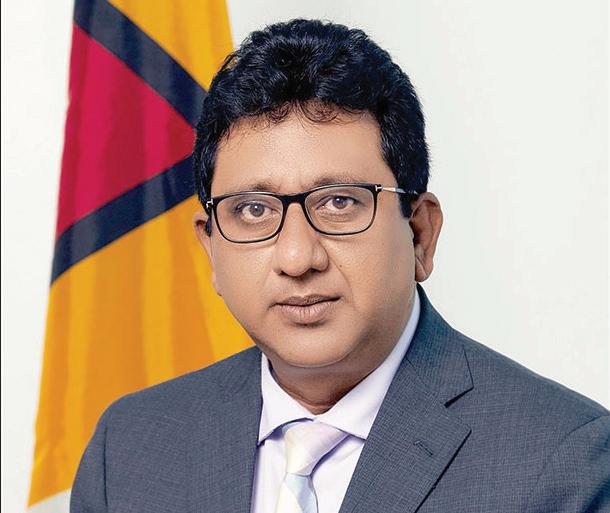
He reminded attendees that there remains a severe void in the global Southern hemisphere for the manufacturing of pharmaceuticals and the capabilities to do so. Fortunately, this
has begun to attract the attention of global health providers.

“Under the astute leadership of President Ali, Guyana will partner with Barbados in leading an initiative in the Caribbean region which is intended conceptually to make the Caribbean self-sufficient in terms of the manufacturing of pharmaceuticals. A lot of work has to be put in to make these undertakings possible,” Nandlall noted.
Guyana and Barbados,

along with Rwanda, are signed on to the Pharmaceutical Equity for Global Public Health Equity, an initiative that would see pharmaceutical companies here eventually manufacturing drugs for distribution to Caribbean, Latin American and African countries.
The initiative was launched in November 2022, on the sidelines of COP 27. There was an open invitation to other countries in the Caribbean, Latin America and South Africa to sign on to it.
The initiative aims to develop and manufacture 60 per cent of all essential, contemporary pharmaceuticals for the populations of Latin America, the Caribbean, and Africa within their respective continents by 2040.
It is intended for the cooperation to focus on next-generation oncological drugs, preventive and therapeutic vaccines, as well as on modalities for women’s health.
Talks of the need for regional security in the availability of drugs and pharmaceuticals have come into stark focus since the COVID-19 pandemic, which highlighted the global disparity in the manufacturing and distribution of vaccines, when small nations struggle to procure vaccines, even as many developed nations stockpiled vaccines for their populations.
“One of the hardest tasks I had so far as President was to sit at the other end of a telephone speaking with vaccine manufacturers across the world and hear them say to me, ‘Yes, we can give you [vaccines] but three years from now,” President Ali noted, as he too delivered remarks on Saturday at the hospital’s opening.
He reiterated his government’s commitment to working towards security for the region in the manufacturing of drugs and pharmaceuticals.
“Never again must
Guyana and this region find itself at the mercy of such a system…, not again should a developing world find itself at the mercy of such a system. We are going to do all it takes to build our capacity with this region so that this region and Guyana and you, the people, will never, ever be left at the mercy of a system that does not deliver,” Dr Ali pledged.
Last year, while attending the sod-turning ceremony for a new mRNA vaccine factory in Rwanda, President Ali had indicated a desire to establish a local vaccine production facility here. India, a world leader in this sector, has already expressed a strong desire to work along with Guyana on this initiative.
President Ali has said that the establishment of a local vaccine production facility in Guyana is a significant step forward in the country’s efforts to improve healthcare, and strengthen its healthcare infrastructure.
POLICE are investigating the circumstances surrounding the death of Nathaniel Nelson, a 14-year-old Line Path Secondary School student, which occurred around 07:30 hours on Sunday at Orealla Village, Corentyne River.
According to a statement, the initial investigation revealed that Nelson, who is from Crabwood Creek, Corentyne, Berbice, was with a group visiting Orealla when he, along with others, handed over their cellular phones to a relative and left in an

unknown direction.
“They went swimming and played (Ready - Ketcha) in the creek when Nathaniel went into the water, began struggling, and disappeared. As a result, a search party was formed, and subsequently, the body was
retrieved at about 10:15 hours today,” the police said.
Nelson was taken to Orealla Health Centre where he was pronounced dead on arrival by a doctor on duty.


Investigations are continuing.

AS the Ministry of Health advances its efforts to improve the services offered across the country, the residents of Region Two will soon benefit from rehabilitated facilities and the anticipated increase in medical personnel.
The Prime Minister’s Representative and PPP/C councillor, Arnold Adams, recently disclosed that massive improvements are un-


derway at the various health facilities.
He explained that the focus is not only on infrastructure, but also on increasing the region’s human resource capacity.
He disclosed to this publication that more nurses are currently being trained, which will eventually increase the number of medical personnel in the region.
Adams, who is also the
chairman of the region’s Health and Sanitation Committee, said that currently the nursing assistant programme is ongoing and when the 50 persons have completed their training, another 50 will be trained.
He said while the ministry is working to increase the human capital in the region, several infrastructural works are ongoing at the Suddie Public Hospital.



The roof of the hospital is currently under renovation, while a multimillion-dollar contract was recently signed for extension of the nurse’s hostel, which will house trainee nurses and medical staff from farflung areas.
Several other development projects which are currently being executed at the hospital will improve the
look of the facility as well as the patient experience. Meanwhile, Adams said
TURN TO PAGE 12


FROM PAGE 11
that dental services are now available to residents in areas such as Good Hope and Queenstown.
He explained that a dental x-ray service is now available at the Suddie Public Hospital, making access to “top-class” dental services much easier.
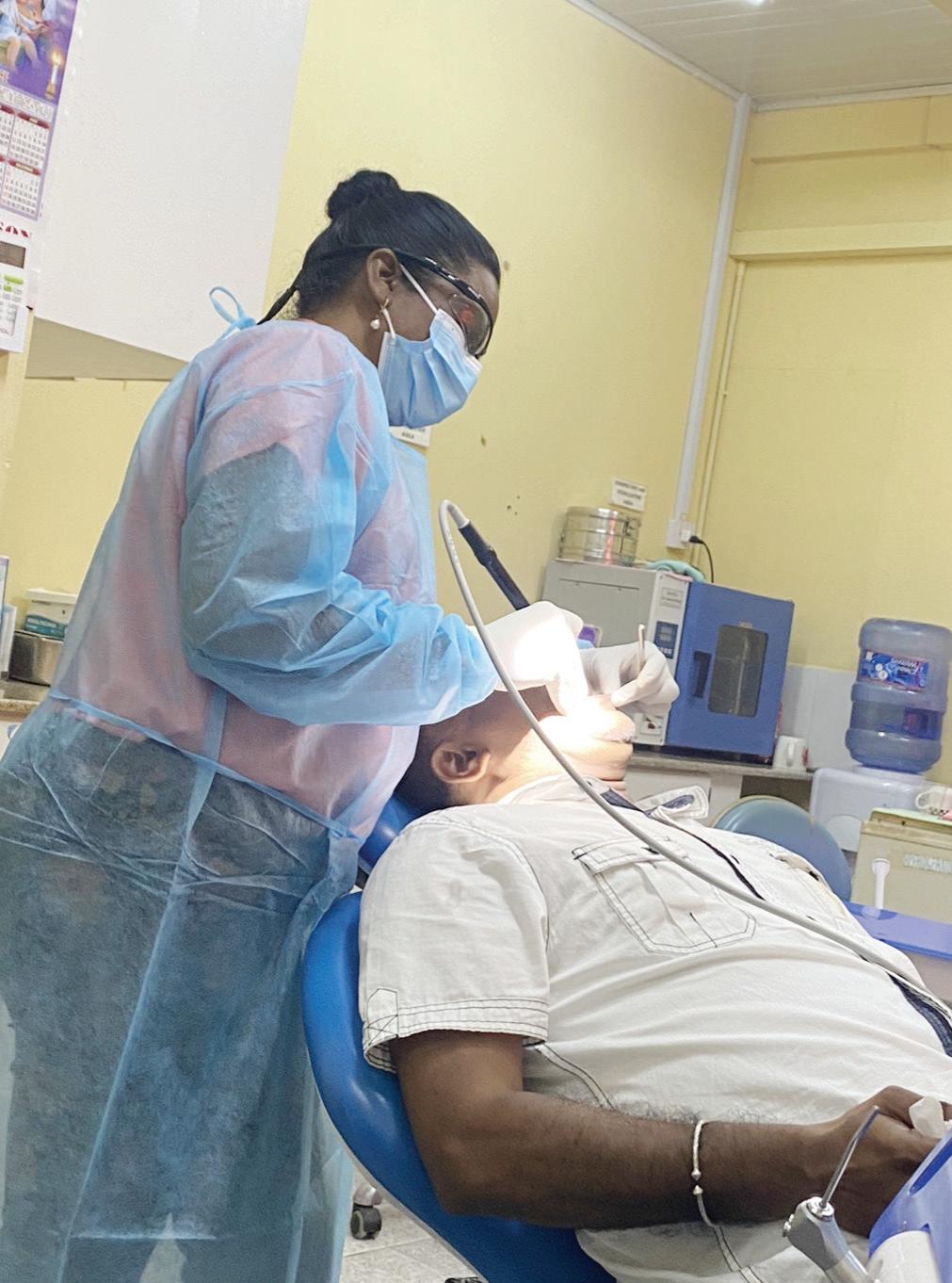
He added that most of the equipment that is avail-
able at the Georgetown Public Hospital Corporation (GPHC) is now available in Region Two and patients no longer have to travel outside of the region to access health services.
“Our Minister of Health is making strides to ensure that Region Two’s health sector is moving from one level to another. We continue to see progress in Region
Two,” Adams asserted. Additionally, he disclosed that dialysis treatment is available in the region for kidney patients. More drugs are also available and according to Adams, the dispensary service is available up to midnight at the Suddie Public Hospital.
The region also received two ambulances recently to
help in transporting patients. In the event of a delay, a water ambulance is available to transport a patient from Supenaam to Parika.
“We are trying our best to ensure that every person who goes to the health centre or post does not leave without that medical attention or drugs. We continue to do medical outreaches in the Pomeroon River to en-
sure that the persons in the hinterland access medical support, even though there are health posts there,” Ad-
access to healthcare in the region has improved and residents are living a much more comfortable
ams further explained.
Adams added that
life, knowing that essential services are available.
AS the various stakeholders continue to work to turn Guyana into a major tourism destination, the Ministry of Tourism, Industry and Commerce is currently completing a master plan for the Essequibo River that will focus on capacity and infrastructural development to further support that area as a massive tourism hub.
The strategic plan is for the development of both the Essequibo Coast and the Lower Essequibo, and involves the development of new tourism products and the expansion and improvement of existing ones. An assessment has been completed and identifying product priority is currently in progress.
tourism spots, the demand is already there.
She explained that given this fact, the focus of the master plan is to approach things in a structured way, build capacity and then market the destination for increased demand.
“We have hired a consultant that will help us to identify the products that will make it into a full circuit, so that when persons come to the Essequibo they experience the entire gamut of the Essequibo, Upper and Lower Essequibo and the entire surrounding regions,” Walrond related.
“The consultant will identify the experience in the master plan and then we will go into the village and we will carry out training. Of course,
will be ready to be delivered to the tourist.”
The longest waterway in Guyana, the Essequibo River stretches for just over 1,000 kilometres from the Acarai Mountains near the Guyana/Brazil border, passing through
resorts in Bartica and the wider Essequibo River. Attractions along the river currently include Baganara Lodge/Island Resort, Saxacalli Beach, the Aruwai White H2O resort, Lake Mainstay and the Hurakabra Nature Resort.
A number of tour agencies in Guyana are currently offering the “Essequibo Day Tour,” which provides a day on the Essequibo River where persons can visit a few of the river’s attractions. The day tour is popular due to its af -
fordability.
Meanwhile, Deputy Director of the Guyana Tourism Authority, Kamrul Baksh, related that as the government looks to widen the Essequibo's tourism product, the upskilling of the labour force is a priority.

“This will raise the bar of service and thus visitor satisfaction,” Baksh said.
Additionally, development of the master plan for the river will support the marketing and promotion of the experiences in the
various locations. It will focus on key areas such as website development and social media marketing.
“The government will support the development of these products, so that travellers will have more choices and a high-quality, safe and sustainable experience. The tourism-related areas are also being addressed, including supporting infrastructure, tourism investment and services,” Baksh said.
Over the years, the ministry has been working to develop an Essequibo tourism circuit which includes parts of Regions Two, Three and Seven, and focuses on upgrades to several of the tourist sites that are located there.

Speaking with the Guyana Chronicle, Minister of Tourism, Industry and Commerce, Oneidge Walrond said that with the Essequibo River already boasting quite a number of

we get the village’s buy-in first, but they've all been receptive and we’ve been collaborating with them.
So, we tell them this is the product that we're going to launch and we get the villagers involved, and we train them, we educate them about what the experience will be like for the entire product-offering. So, for each of the offerings we will be going in and doing training, so then is when the entire product
forests and savannahs before emptying into the Atlantic Ocean at Parika.
The river contains 365 islands, which include eco-tourism hotspots such as Leguan, Wakenaam, Hogg Island, Fort Island -- the former seat of the Dutch government -- Sloth Island, and Parrot Island.
The Essequibo circuit includes the forts, several waterfalls such as the Baracara and Marshall Falls, and a number of tourist


THE contributions of our workers to the advancement of Guyana and our collective, progressive future are invaluable and have been the bedrock of the struggles for betterment for all.
On the occasion of Labour Day 2023, the People’s Progressive Party (PPP) takes this opportunity to extend best wishes and pay homage to their sustained hard work
and indomitable spirit.
The PPP/C Government continues to work assiduously to ensure that our workers are a priority and that their lives and conditions continue to be improved.
This recognition is evident by the emphasis and value placed on their welfare by the immediate re-establishment of the Ministry of Labour upon taking office in August 2020.
We believe that mechanisms to engage and represent our workers must not be diluted and that they must be able to access related services in a structured and holistic manner as is necessary through a Ministry.
While the Party is aware that there is more to be done, it continues to advance a multifaceted approach to ensure the advancement of our
workers. Very early within this current tenure of the government, burdensome taxes and fees were removed and the education cash grant was restored and increased.
To date, thousands of jobs have been created and restored to allow our workers a dignified opportunity to provide for their families.
Further, access to thousands of scholarships to aid
in capacity building and the implementation of various programmes and policies to improve the social and physical infrastructure, are just part of the PPP/C Government’s thrust to better the lives of all workers.
As workers rally in solidarity in celebration of their invaluable contributions to national development, once again, the PPP salutes their resoluteness and innovativeness in advancing our country.
Fellow workers,
TODAY, May Day or Workers Day, we, in the PNCR and the Parliamentary Opposition, pause to say thank you to the thousands of you, past and present, who with your sacrifice of blood, sweat, tears, determination, and dedication committed to the task of nation building, even in the face of oppression and suppression.
We thank you for your continued love for the country amidst the trampling of your rights, the just past pandemic and the others that have plagued you as workers. You have shown great dexterity and resilience and for standing your ground have been bestowed with the crown as CHAMPIONS
Today, it is with humility, strength from those whose back we now stand on, decency and gratitude that we address you, the wheel turners. The theme this year, we find to be apt and fitting as indeed stronger and progressive unions is what is required to respond to the challenges of today which have increased.
However, it must be noted that unions must continue to build capacity among its ranks if it were to achieve
this feat of responding. More than that, union leaders must be equipped with the knowledge, skills and tact to be able to skillfully navigate the path successfully.
As you would have noticed, it is the Workers who have kept the wheels of this economy turning . It is the very workers who have been braving the effects of the high cost of living, non-recognition by an uncaring government, poverty and all the other ills that come along with it, but continue to give of their best, and it is for this simple fact,
We must SALUTE YOU!
Workers, we say, must be valued irrespective of their gender, race, creed, religion, position or job responsibilities. There should be no disparity between men and women, pro-government or anti-government.
This principle is universal and it is one of the front runners that the Labour Movement and its Leaders must hold onto and continue to champion the cause of its implementation.
Unfortunately, the present conditions of work are
still not beneficial to workers, as we have witnessed over the last year the many workplace accidents (both fatal and nonfatal), and the abuses - physical, emotional and sexual in nature - that continue to prevail.
Lives were lost, workers maimed and scared, yet the powers that be see these incidents/accidents as just a mere passing one simply because the ordinary worker is not important to them because you don’t fit into their grouping. As a matter of fact, in their minds and mode of operation it’s “Let’s carry on”.
Our workers/citizens have been working under unacceptable conditions, for longer hours while receiving less money. These kinds of exploitations and atrocities must be fought back by all and sundry.
On this very note we must ask what systems have been put in place to assist the fam-
ilies of so many others who have lost their lives or who have been maimed? What is the government doing to minimise these incidents/ accidents and the penalties? These must be made public.
You, our working class, deserve much better, especially since we, this country of ours, have been dubbed the “New Dubai” of the Caribbean and with the fastest growing economy. Our citizens/ our workers must be able to live a better life. If this government wants us the citizens to take them seriously, then the President should, with immediate effect, commission the Judicial and Public Service Commission.
For too long workers have been burdened with the task of being actors and actresses. Release those loops you have around the necks of our People.
They deserve to be appointed in every sector as is deemed fit by the conditions set out. Workers deserve job security. The President must stop holding contract appointments and acting over the heads of our citizens. May we hasten to add that this process must be free, fair and transparent.
As we have also rec -
ognised that in recent times the government has embarked on a route with the aim of putting workers against each other, and union leaders against each other. This new medicine of control must be rejected forthwith. Let us remind union leaders that you were not elected by the government and that you are not their puppets. You were elected by the workers within the various sectors and your mandate is to serve and represent your membership without fear or favour , so let me caution you, don’t be dragged into the net of selling out your membership for a few pieces of silver because history will not be kind to you. Union Leaders must stand tall, decked out with decency, integrity and a commitment to fight for Equity, equality and fairness. Your struggle in essence should be to ensure and secure jobs, decent livable wages and conditions of work for your membership. We ask you leaders to raise your voice for better healthcare and secured retirement packages. As we are reminded by Aristotle who said, “Pleasure in the job puts perfection in the work.”
In conclusion, the time has come for all of LABOUR to demand the return of collective bargaining. It is from this standpoint that our Citizens/our Workers will be given their rightful due. We must no longer accept across the board increases as this does not cater for inflation and the specifics as is required in the various sectors. This government must return to the table with union leaders. There’s an old saying that says, “Come see me and come live with me is a different thing.” We have seen that with this government and let us remind them: when you were in opposition you championed the call for the return of collective bargaining. You are in government now, do it!
Just in case you didn’t know, Labour is the Ladder through which Human Dignity and Creative Excellence is expressed.
So, today and for every day, we will continue to salute you the Working Class, who have stood to the task of Nation Building amidst the challenges.
Long live the Working Class! Happy Labour Day!
THE Ethnic Relations Commission, (ERC), extends Labour Day greetings to all workers and salutes their invaluable contributions over time for the upliftment of the labour sector and the development of Guyana.


The Guyanese working
class experienced many painful and fatal challenges in its early years but the labour movement evolved, notwithstanding the adversity prevalent at the time
The movement represents a significant segment of workers and its role as a critical stakeholder is
invaluable in the ERC ’s objective to promote ethnic harmony in the workplace.
The ERC therefore, embraces any initiative to empower citizens through education and training to equip them for Guyana’s accelerating economy
The Commission joins
the social partners represented by government, employers, employees and the trade unions in recognition of their efforts to continuously improve the social and economic well-being of citizens; increase in productivity is achieved through the collective efforts of all.
May 1 is an occasion annually that honours workers in their struggles and the Commission remains in solidarity with them, and values the importance of labour in every sector of the economy.
Happy Labour Day to all!
President, Dr Irfaan Ali, has been continuously meeting members of the diplomatic community to discuss matters of mutual importance and areas of possible collaborations These Office of the President photos capture some of those engagements
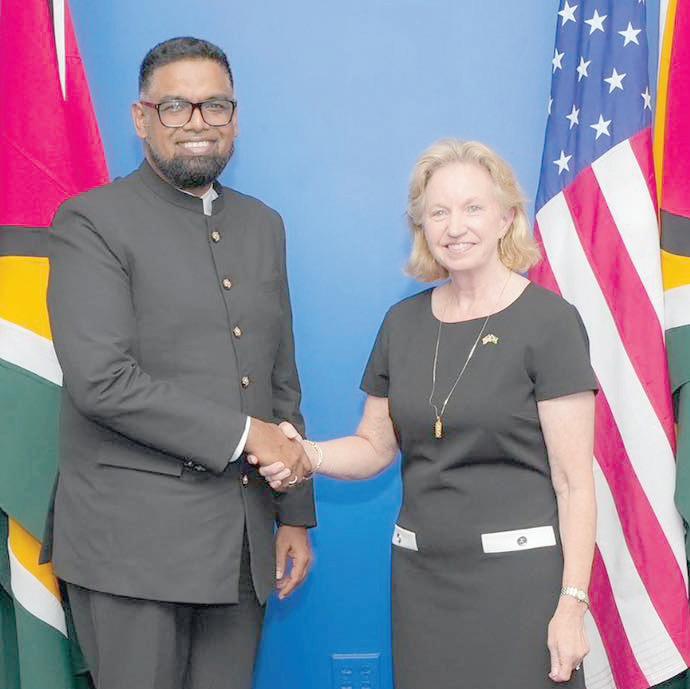

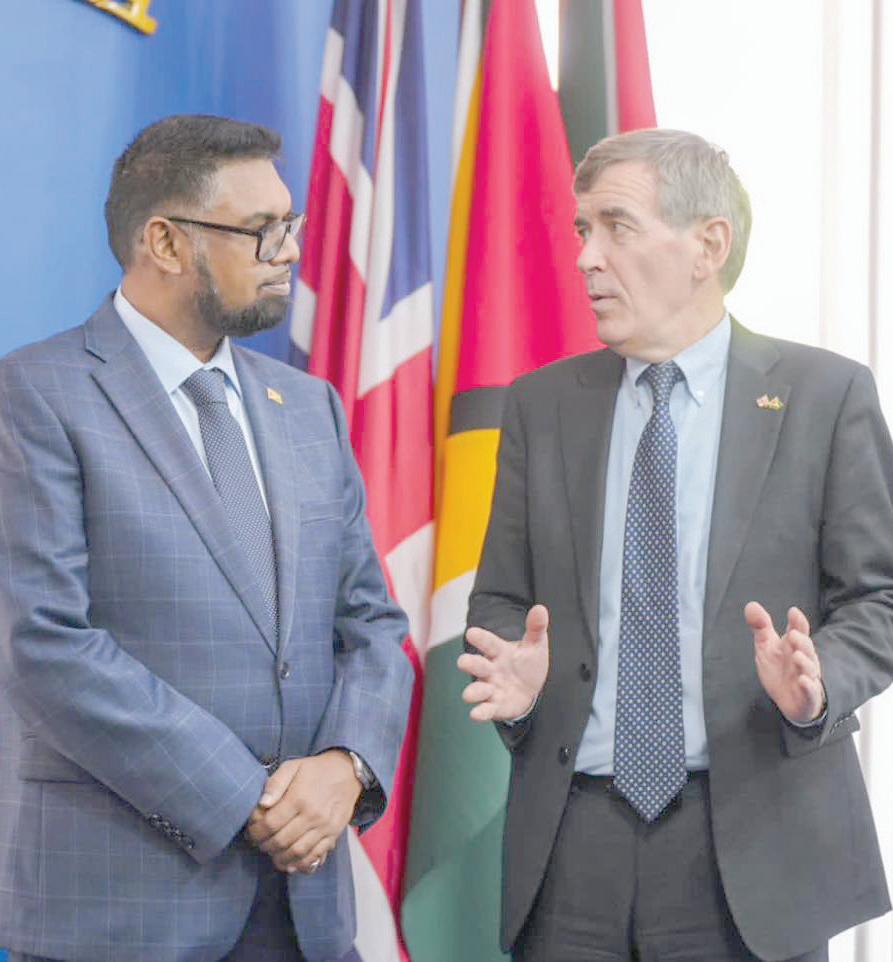
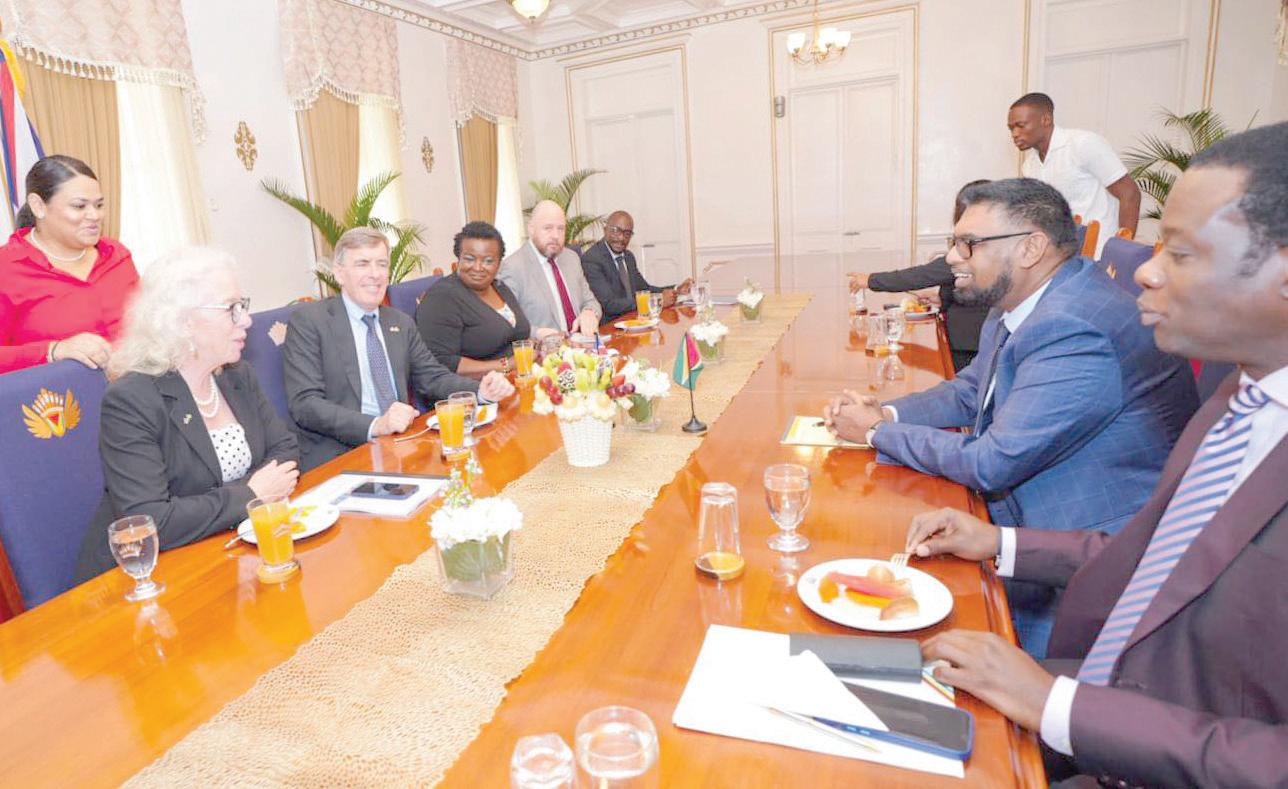


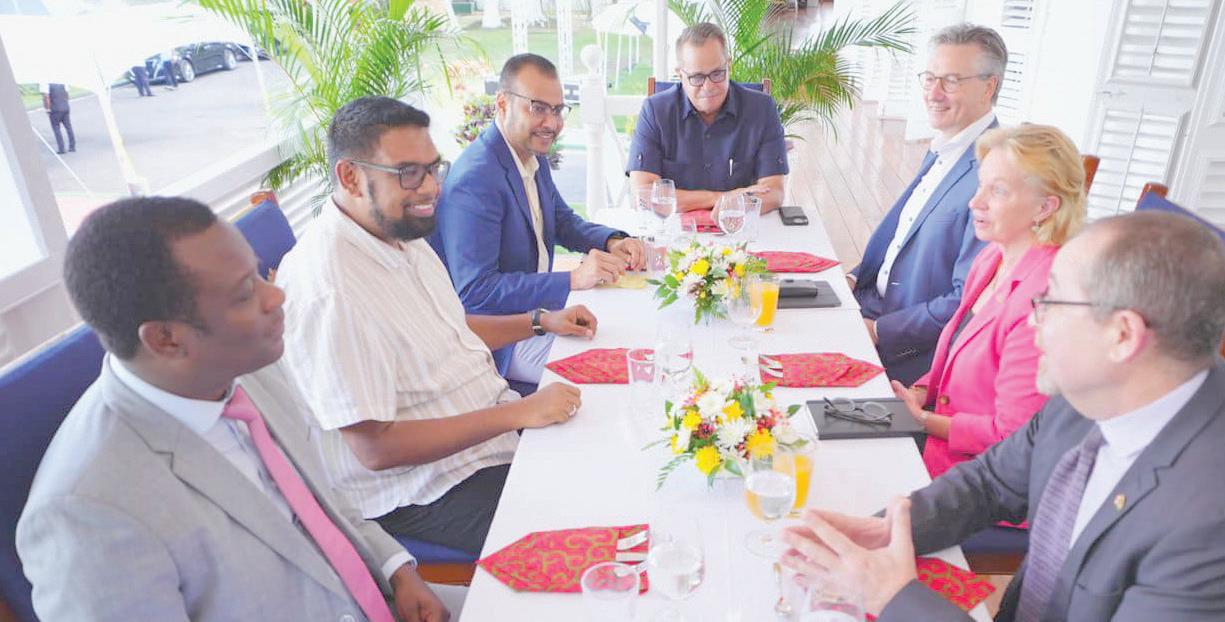
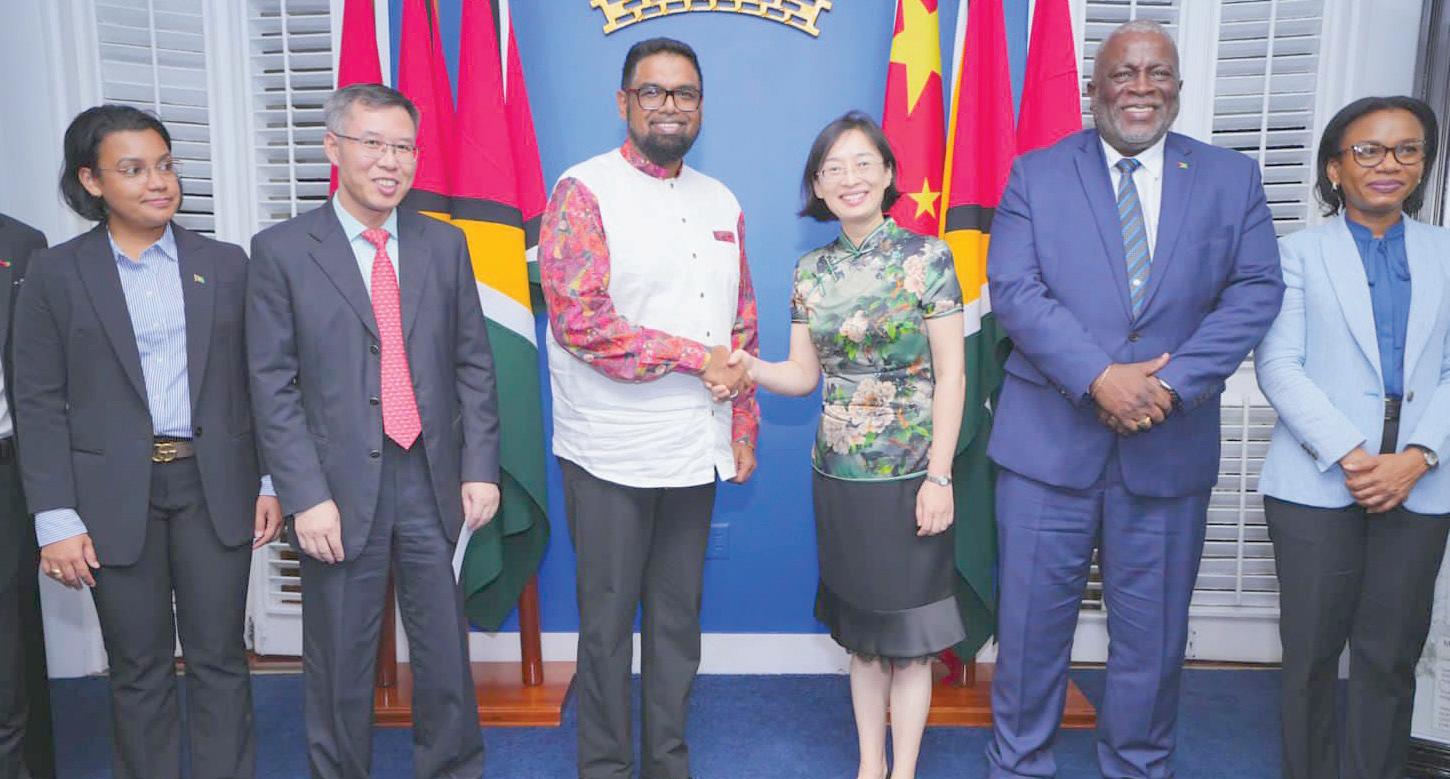

ASSURIA General and Life Insurance Company, on Saturday, formally unveiled its new state-of-theart $1 billion head office which will be offering Guyanese cutting-edge products that are of an international standard.


The five-storey building is located at the corner of Church and Carmichael Streets.
What started as humble beginnings in March 2012 with no clients and only a dream of winning the public's heart with innovative products and first-class customer service, has developed into one of Guyana's top insurance companies which now has more than 20,000 clients.
Prime Minister, Brigadier (Ret’d) Mark Phillips, Senior Minister in the Office of the President with responsibility for Finance, Dr Ashni Singh and Suri-
name’s Ambassador to Guyana, Liselle Blankendal, were among the dignitaries in attendance.
During his feature address, the PM commended the insurance company for not only investing in Guyana’s economy, but for also catering to the needs of citizens.
Labelling Guyana’s financial sector as “solid, stable and secure,” the PM asserted that this security is connected to the government’s unwavering commitment to implementing policies to regulate the sector.
He highlighted the value of insurance and the part it plays in Guyana's financial industry, before emphasising the need for solid management so that the sector can continue to grow.
Speaking on Guyana’s economy, he said: “We anticipate financial sector growth of
around 7 per cent this year. With a growing economy, the prospects are bright for our local insurance companies.”
Owing to key role
insurance companies are playing, the PM said: “In recognition of this important role of our country's financial development, govern -
ment has taken steps, through local content legislation, to support the local industry capitalising on the expanding economy, especially the oil and gas sector.”
On the human side of things, Phillips said: “Insurance is not some abstract financial concept. It is rooted in circumstances of human existence, and specifically the risks which we all face.”
He further said that more education is needed for persons to understand the importance of insurance.
“Too many of our citizens’ lives are not insured and only a fraction of our population benefits from pension schemes and health insurance,” he added.
Meanwhile, Managing Director of Assuria, Yogindra Arjune, said: “This building represents the accomplishment of a dream."
The "Assuria Way,"
as Arjune dubbed it, defines the path for them to become "a family of innovators and market leaders in every aspect."
He disclosed that the company will continue its strict focus on the clients and the adoption of global standards to exceed all expectations.
He continued by praising the government for its ongoing assistance in creating a favourable climate for direct investment under the leadership of President, Dr. Irfaan Ali.
According to him, the actions taken so far have greatly increased investor confidence.
"The ones who are very close to me can attest to my support and admiration of a President who have created the ‘One Guyana’ concept." he affirmed.
Following the ribbon-cutting ceremony, the PM and other officials toured the edifice.





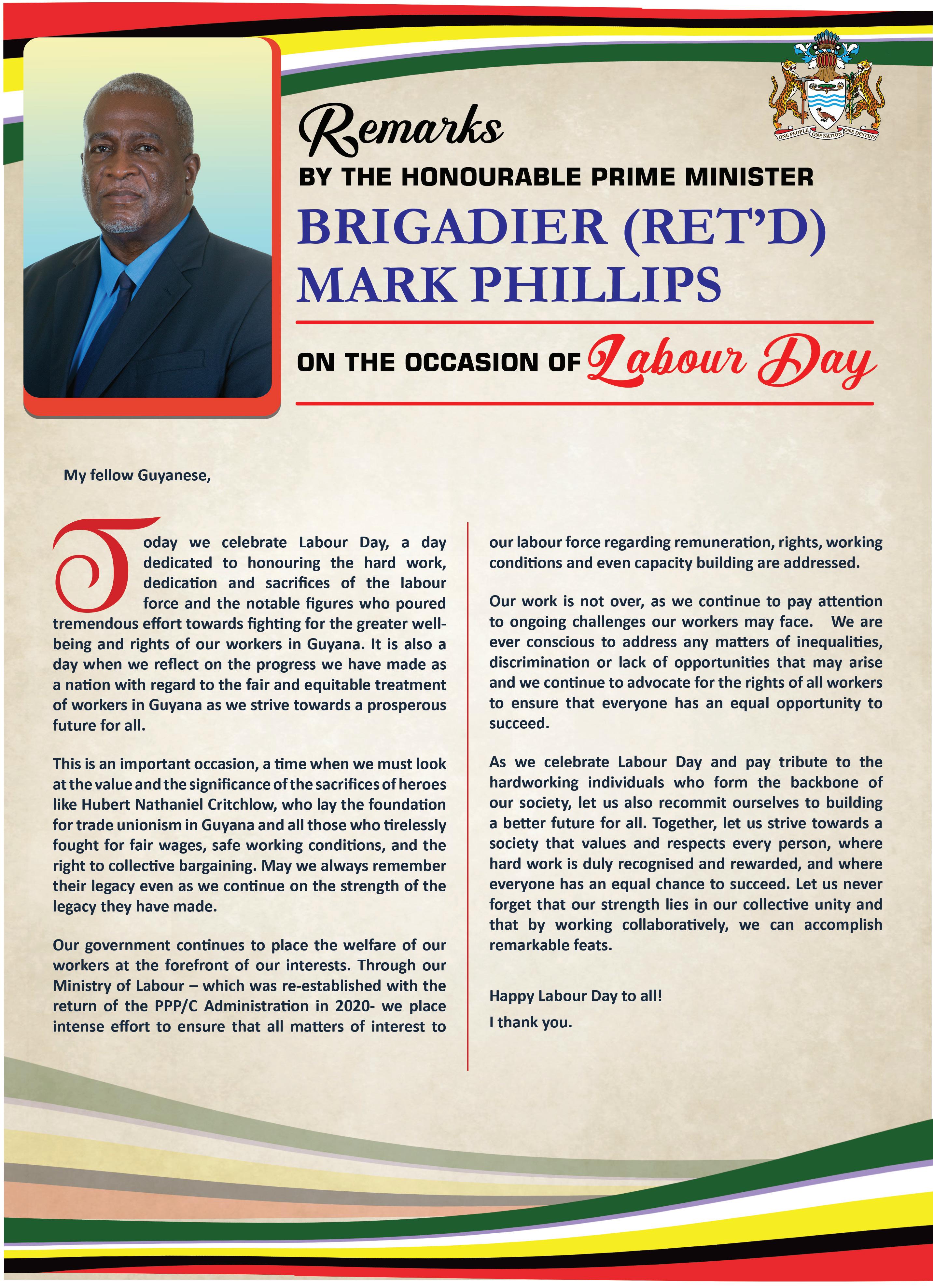

THE police are investigating the murder of 45-year-old handyman, Wafad Wahab, known as “Ricky”, who was fatally stabbed in the vicinity of Strikey's Bar on New Road, Vreed-en-Hoop, on Saturday.
According to the police, Wahab, who plied his trade at the Stabroek Market, resided at Lot 6 Harlem, West Coast Demerara.
It is alleged that on April 29, at about 18:00

hours, Wahab went to New Road to visit his aunt, who had arrived from the United States last week.
When Wahab arrived at the home, his aunt saw that he was under the influence of alcohol, and reportedly told him that she did not like seeing him in such a condition, so he must go home, relax, and return the following day to see her.
Wahab then left and walked east on New Road,
where he was attacked by the suspects in the vicinity of Strikey's Bar.
"An eyewitness said the suspects rode off on bicycles in a northerly direction into Evergreen Street and escaped. After the attack, the victim got up and staggered into Strikey's Bar, where the proprietor heard a customer shouting: ‘Watch this man bleeding hay, boy,’" the police said in a release.
The proprietor of the
shop immediately called Vreed-en-Hoop Police Station, and a police vehicle with ranks arrived within minutes.
The police took Wahab's shirt and tied his right hand, placed him into the vehicle, and drove off. The police escorted Wahab to the West Demerara Regional Hospital, where he was pronounced dead by a doctor on duty.
The body was clothed in short khaki pants and a pair of brown "safety"
boots. The body bore one wound to the left shoulder, one to the lower left back, one to the outer and one to the inner part of the right hand, close to the elbow, and one to the right side (ribs area).
The body was photographed and then escorted to the Ezekiel Funeral Parlour for a post-mortem examination.
The deceased had a grey Samsung cellphone, and $1,040 (Guyana currency) in his pants pock-

et were photographed, marked, and lodged.
The police photographed the crime scene and found what appeared to be bloodstains on the southern side of the road.
The area was also canvassed, and several CCTV cameras were seen, and footage is currently being extracted.
Checks are currently being made for the suspects. Statements have been taken as investigation is ongoing.










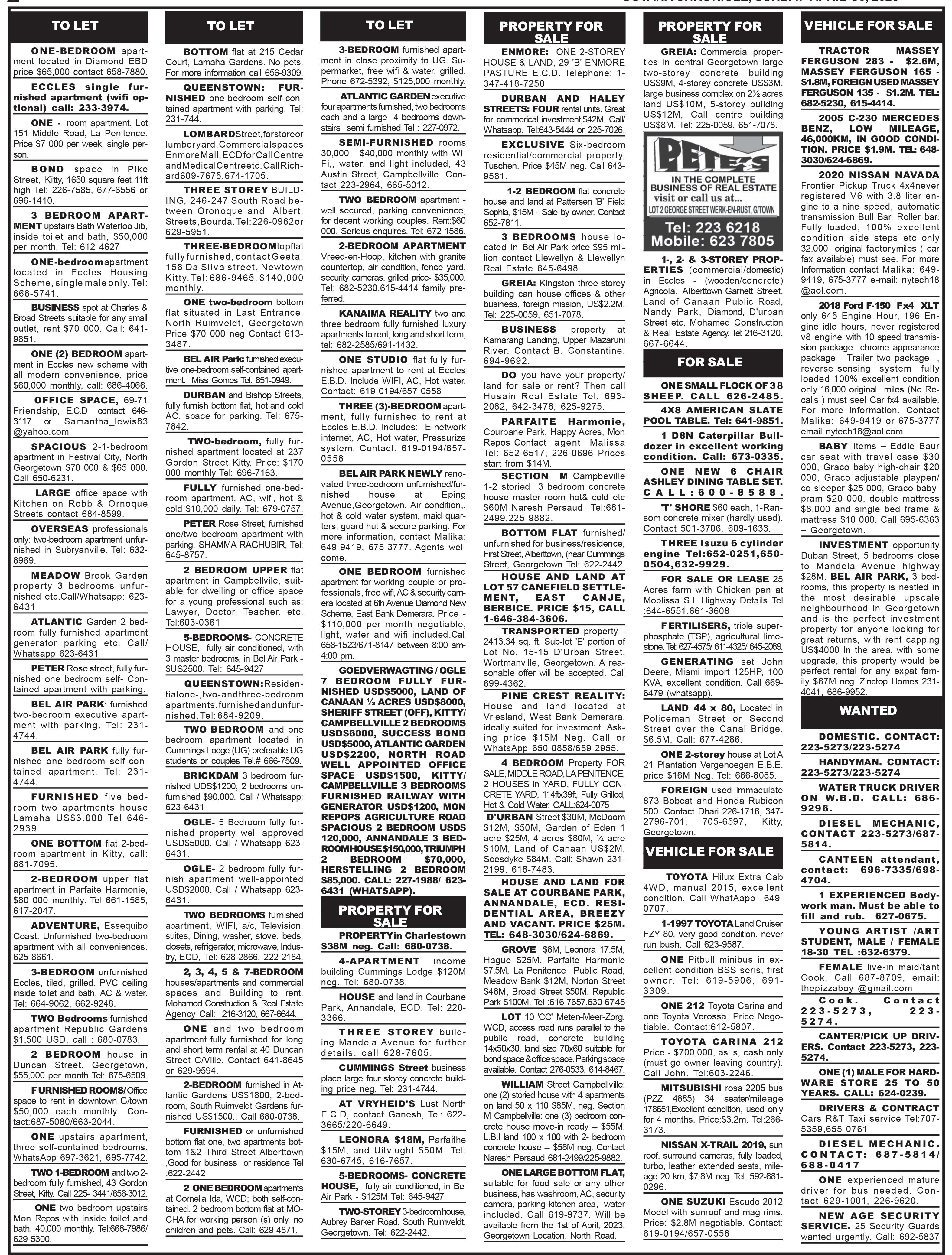
FROM BACK PAGE Six,

shots," he smiled. "It was good to bat at the end. Amazing feeling to win like that.
Earlier, in Chennai, the home Super Kings were beaten in another dramatic finale by Punjab Kings' Sikandar Raza, who guided his side to a four-wicket victory off the final ball.
Needing three off the final ball, the Zimbabwe batter pulled to the vacant square leg area and ran the decisive three to reach 6-201, earning a victory which had looked a tall order after New Zealand's in-form Devon Conway had cracked 92no off 52 balls in Chennai's 4-200.
(Monday May 01, 2023)

COMPLIMENTS OF CUMMINGS ELECTRICAL COMPANY LTD- 83 Garnett Street, Campbellville, Georgetown (Tel: 225-6158)
Answers to yesterday’s quiz:
(1) Morne Morkel-25 wickets (DD)
(2) Ravindra Jadeja-5/16 (CSK vs Deccan Chargers)
Today’s Quiz:

(1) Which WI wicketkeeper effected most dismissals in IPL 2012?
(2) What was the highest partnership recorded in IPL 2012?
Answers in tomorrow’s issue


SRI Lanka spinner Prabath Jayasuriya, the man who dominated Australia on Test debut nine months ago, has become the fastest tweaker to 50 wickets in men's Test history.
With the wicket of Ireland's Paul Stirling, caught by Kusal Mendis on the fifth day in Galle, Jayasuriya claimed his seventh wicket of the match and 50th overall, reaching the milestone in his seventh Test, having bowled in 13 innings.
In both instances, it's a record for a Test spinner, surpassing the mark set by West Indian Alf Valentine 72 years ago, who took eight Tests and 15 innings.
Holding the overall record is 19th-century Aussie pace bowler Charlie Turner, who reached 50 wickets in
his sixth Test having bowled in only 10 innings.
However, for cricketers active this side of 1900, only South African quick Vernon Philander can match Jayasuriya's stunning feat (he also registered his 50th Test wicket in his seventh Test and 13th innings).
Jayasuriya made his debut as a 30-year-old in the second Test against Australia last July.
Brought into the side only due to Praveen Jayawickrama's Covid-19 diagnosis, Jayasuriya played a match-winning role as Sri Lanka squared the series.
The left-arm spinner claimed 12-177 for the match, the fourth-best figures by a debutant in Test history, bamboozling the tourists to complete a fa -

mous win for the Lankans. Perhaps due to nerves or perhaps due to the supreme skill of Marnus Labuschagne and Steve Smith, Jayasuriya's first 12.4 overs went wicketless and cost him 56 runs.
But his maiden wicket, that of Labuschagne stumped for 104, proved a turning point from which Jayasuriya would not look back.
The 17 wickets in two matches against Pakistan in the series that immediately followed proved his first game was no fluke.
A big gap in Sri Lanka's Test schedule meant he'd have to wait almost eight months until his next match, a two-Test series in New Zealand, which netted the spinner four wickets.
But the arrival of Ireland to the shores of Sri Lanka was a blessing for the veteran tweaker, earning player-of-the-match honours with 7-52 and 3-56 in the first Test and another five-wicket haul in the first innings of the second.
Fewest matches to 50 Test wickets
6 – Charlie Turner (Australia), 1888
7 – Prabath Jayasuriya (Sri Lanka), 2023
7 – Vernon Philander (South Africa, 2012
7 – Tom Richardson (England), 1896
8 – Fred Spofforth (Australia), 1883
8 – Alf Valentine (West Indies), 1951
8 – Rodney Hogg (Australia), 1979
8 – Terry Alderman (Australia), 1981
SERGIO Perez's accomplished victory in the Azerbaijan Grand Prix has confirmed - in his mind at least - that he is a genuine rival to his Red Bull team-mate Max Verstappen for the world championship this year.
Not everyone is as convinced as the Mexican - not even his team principal, judging by Christian Horner's comments afterwards - but Perez certainly laid down a marker around the streets of Baku.
"It's a long year ahead," Perez said after shrugging off everything the two-time champion could throw at him and controlling the race around the streets of this city on the shores of the Caspian Sea. "We are in the fight."
It was a highly consummate performance from Perez. Arguably - even if he was reluctant to say so himselfthe best of his six Formula 1 victories.
Perez did, as Horner said, "get a little bit lucky with the safety car" but, once in the lead, he controlled the race. Throughout a tense grand prix, with both drivers pushing to
the limit throughout, Verstappen had no answer for him.
2-2 between Verstappen and Perez
Perez's win, together with his victory in Saudi Arabia two races ago, makes the score two-all between the Red Bull drivers so far this season.
The six-point lead Verstappen has is down entirely to a difficult qualifying day for Perez at the previous race in Australia, where technical issues left him down the grid and required a comeback drive. It was not by chance that Perez mentioned several times over the weekend that he and the team needed to avoid weekends like that.
There were no errors from Perez or his side of the garage this time, and he left Azerbaijan for the 15-hour flight to next weekend's race in Miami with two wins under his belt - one in Saturday's shorter 'sprint' and another in the grand prix - to make it an almost perfect weekend.
And while it is true to say Perez was gifted the lead by the timing of the safety car, that is not the same as saying
he lucked into the win.
Perez closed in on Verstappen once both were past the pole-winning Ferrari of Charles Leclerc and was putting him under pressure. Verstappen radioed that he was starting to run into tyre problems.
By the end of lap nine, Perez was just 0.6 seconds behind and felt he was on the point of passing his team-mate by using the DRS overtaking aid. At this point, Red Bull stepped in and stopped him getting the chance by calling Verstappen in for new tyres next time around.
The idea was to keep Verstappen in the lead but it backfired. Red Bull had seen the Alpha Tauri of Nyck de Vries in the run-off area at Turn Six but miscalculated.
They thought the incident was not enough to bring out the safety car, felt the Dutchman's car was undamaged and he would reverse back on to the track, so brought Verstappen in, rather than waiting another lap for a safety car. (BBC Sport)
WHEN Fakhar Zaman has these kinds of days, there's very little any side can do about it; and what makes him so special is he has days like these with frightening regularity. A third successive ODI hundred - this one a monster century - by Pakistan's premier ODI opener blitzed New Zealand, as he cracked an unbeaten 180 off 144 balls.
It helped his side coast to their second-highest chase in the format, running down New Zealand's 336 with seven wickets and almost two overs to spare. A 135run stand with Babar Azam, who scored 65, formed the backbone of the chase, while a devastating counter-attacking partnership with Mohammad Rizwan swept the game out of New Zealand's reach.
(Scores: Pakistan 337 for 3 (Fakhar 180*, Babar 65, Shipley 1-58) beat New Zealand 336 for 5 (Mitchell 129, Latham 98, Rauf 4-78) by seven wickets)
New Zealand had done plenty of things much better than they did in the first ODI, and yet, this game simply felt like a repeat. Daryl Mitchell scored a hundred, and New Zealand set themselves up for a huge total. And while they did get much further along than they managed in the first ODI by posting 336, a tight final three overs from Pakistan ensured the hosts grabbed some momentum at the death.
And Pakistan began the
chase brightly once more, though Matt Henry did strike to remove Imam-ul-Haq in the final over of the powerplay; but the hosts kept coasting at above seven runs an over. Coming in at No. 3, Babar struggled through the first few overs of the innings, scoring just 16 runs
through, until an unforced error from Babar himself provided the breakthrough. He had tonked Sodhi for a six and a four in the 30th over, before a leading edge saw the ball fly up to Chad Bowes at short cover.
overs thanks to a rock-solid bowling display by Pakistan, there would be less of a let-up at the death this time. New Zealand cranked through the gears in the final few overs to press home the advantage of the dominant position they had worked themselves into by plundering 98 runs in the final ten overs, with their innings featuring Mitchell's career-best 129 off 119 balls.
in his first 25 balls. Thus, the onus fell on Fakhar to ensure Pakistan remained on top of the asking rate, a burden he fulfiled with aplomb.
The real acceleration came in the 21st over when he launched Ish Sodhi for 17, speeding along to his tenth ODI hundred. He had brought up three figures in 83 balls, before launching Rachin Ravindra for a huge six over midwicket, as by now Pakistan were purring. Babar had rediscovered his own touch too with a pair of boundaries against Henry Shipley, and was coasting towards another half-century.
New Zealand ran through the bowling changes but could simply find no way
The visitors were then provided a glimmer when debutant Abdullah Shafique was prised out by Shipley, but Rizwan hit back with another effective counterattacking knock. It began with a regal cover drive off the first ball and continued with the same elegance. Fakhar had much of the pressure taken off him as both experienced batters tore chunks out of the bowlers, particularly the inexperienced Ravindra.
Fakhar brought up 150 and carried on, while Rizwan's own half-century arrived off the penultimate ball he faced as Pakistan eased to the win in the end.

Earlier, Mitchell's second successive hundred of the series had helped New Zealand to an imposing total of 336. A 183-run stand for the third wicket between him and his captain Tom Latham was the foundation of New Zealand's biggest ODI total in Pakistan, with Latham's 98 from 85 balls ensuring his partner had plenty of support at the other end.

Unlike the first ODI where New Zealand fell away sharply in the final ten
Pakistan had won the toss and reprised the decision to field first, and while New Zealand made a more urgent start than they did on Thursday, Haris Rauf struck to remove Will Young early. But aside from Naseem Shah, whose accuracy and menace forced them into caution, no pace bowler was really spared. Ihsanullah, making his debut, bore the brunt of the third-wicket partnership's punishment. Rauf wasn't spared either, and in the 17th over, Mitchell tonked him for a four and a six, bringing up the side's
100. Haris struck again after Bowes reached his maiden fifty, but it brought together the defining stand of the innings when Latham and Mitchell got together. Latham had found strokeplay a struggle on Thursday, but had no such problems on the day, getting off to a brisk start and milking the spinners effectively. Mitchell looked characteristically imperturbable, and New Zealand's platform was being built beautifully.
Pakistan were sloppy in the field in the first game, and must have rued the chance to get rid of Mitchell before he brought up three figures on Saturday too.
Naseem put down a dolly at mid-on in the 39th over, with Mitchell four away from the milestone, thus denying Usama Mir the wicket his bowling deserved.
Four balls later, Latham pulled Mir away for four to bring up his own half-century, while Mitchell eased
his way to a hundred the following over.
The shackles were broken at that point, and in the absence of the same quality from the Pakistan bowlers as in the first ODI, run-scoring was easier. The final 11 overs brought 107 runs for New Zealand, with Latham central to much of the boundary-hitting. He was denied a century when, in the 47th over, Pakistan reviewed a not-out verdict to find that Latham had inside-edged to the wicketkeeper off Rauf when on 98.
And eventually, a tight final three overs from Pakistan ensured New Zealand were kept below the 350 they had threatened.
But with Fakhar and Pakistan in this chasing form, there's little to suggest even that would have been enough on a day Pakistan motored along in Rawalpindi, while New Zealand petered out. (Cricinfo)
Chris Jordan has joined Mumbai Indians as a replacement player for the remainder of IPL 2023.
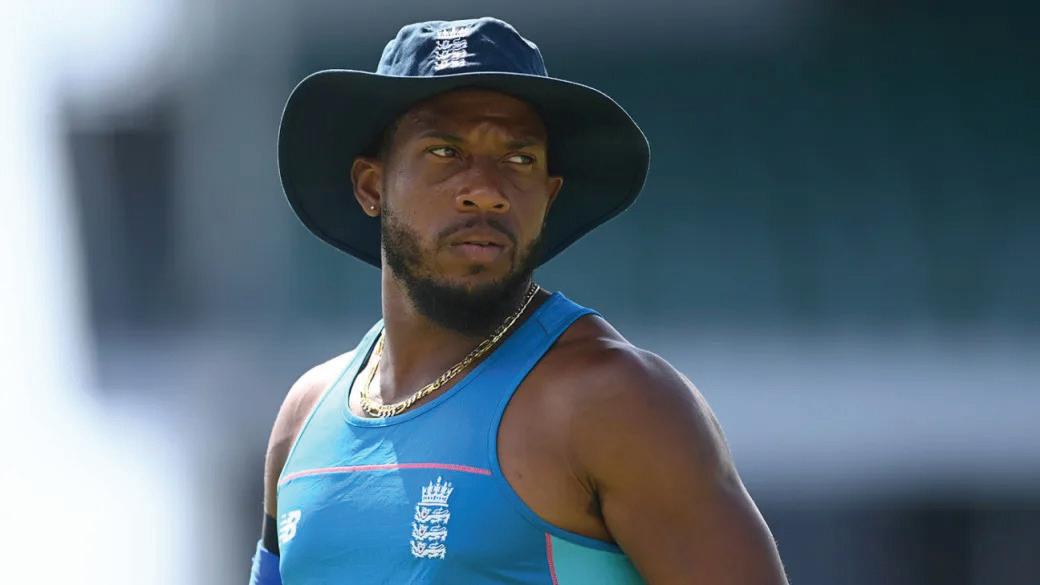
Jordan went unsold at a base price of INR 2 crore at the auction that was held in December last year, but has previous IPL experience with Royal Challengers Bangalore, Sunrisers Hyderabad, Punjab Kings and Chennai Super Kings.
The 34-year-old has picked up 27 IPL wickets in 28 innings at an average of 30.85 and an economy of 9.32. Jordan last played in the IPL in 2022 for Super Kings, where he managed two wickets in four outings.
Mumbai have struggled with their international fast bowlers this season with Jasprit Bumrah unavailable, Jhye Richardson ruled out and Jofra Archer recently
returning from Belgium after meeting an elbow specialist.
While Riley Meredith replaced Richardson, it is not yet known who Jordan has replaced in the Mumbai camp.
Jordan has recent T20 experience with a season with eventual champions Gulf Giants at the ILT20 tournament in February. He finished the tournament as the
leading wicket-taker, picking 20 wickets in ten innings, averaging 13.80. He also played three T20Is against Bangladesh last month. Archer is expected to play for Mumbai on Sunday evening against Rajasthan Royals, with the side hoping to move up from ninth on the IPL points table.
MANCHESTER City beat Fulham to return to the top of the Premier League as Erling Haaland scored his 50th goal of the season in all competitions.

Haaland converted a third-minute penalty, after Julian Alvarez had been fouled by Tim Ream, to become the first top-flight player to reach a half-century of goals in one campaign
er registered for Blackburn a year later.
However, Fulham grabbed a 15th-minute equaliser with their first attempt of the match as Carlos Vinicius powerfully shot past Ederson after Harry Wilson had headed the ball into his path.
But the hosts could not hang on to record what might have been a remarkable re-
of - Arsenal, with Pep Guardiola's side having a game in hand.
Relentless City hunt another league title
This was City's first match since the 4-1 win over Arsenal on Wednesday, which left them in control of the title race as they aim to become English champions for the fifth time in six seasons.
They were without influ-
City a penalty, which Haaland scored for his 18th goal in his past 12 matches.
Argentine striker Alvarez, who helped his country win the World Cup in December, grabbed his eighth Premier League goal of the season with a superb strike to restore City's lead.
They had further chances as both Haaland and Alvarez were denied by smart low stops by Bernd Leno, with Fulham unable to grab an equaliser despite late pressure.
Guardiola's side, unbeaten in 18 games in all competitions
and without a loss since 5 February, have six Premier League games left and need to win five of them to retain their title.
Their next matches are at home to struggling West Ham and Leeds on 3 and 6 May respectively, before the first leg of the Champions League semi-final against Real Madrid in Spain on 9 May.
This is the first time City have been above Arsenal since mid-February as they aim to win the Premier League, Champions League and FA Cup treble.
Is Fulham's season running
out of steam?
Fulham won the Championship last season and were sixth in mid-February, dreaming of qualifying for Europe, before a run of five losses in seven matches before this match at Craven Cottage ended those hopes.
Marco Silva's side are 10th and aiming for their first top-10 finish in the top flight since 2011-12. They were only behind for 12 minutes following Haaland's penalty, before Vinicius equalised against the run of play.
Sikandar Raza scored the winning runs off the final ball as Punjab Kings beat Chennai Super Kings by four wickets in a thrilling Indian Premier League contest.

Only Ruud van Nistelrooy in 2002-03 (for Manchester United) has a better 100% record for penalties in a Premier League season (eight out of eight) than Haaland in 2022-23, who has scored all seven he has taken
since Tom 'Pongo' Waring did so for Aston Villa in 1931.
The Norwegian striker also moved level for most goals in a Premier League season - matching the 34 goals Andy Cole scored for Newcastle in 1993-94 and the same amount Alan Shear-
sult.
Jack Grealish had an effort pushed on to the crossbar for Manchester City, who regained their lead in the 36th minute through Alvarez's superb strike from 25 yards out.
City's win moves them above - and one point clear
ential midfielder Kevin de Bruyne, who Guardiola said "was not feeling good", while Bernardo Silva was on the bench and Riyad Mahrez and Alvarez were brought into the side.
Alvarez made an instant impact as he was fouled by Ream's clumsy trip to earn

Serge Gnabry and Kingsley Coman scored as Bayern Munich beat Hertha Berlin to reclaim the top spot in the Bundesliga.
Gnabry's diving header opened the scoring following Joshua Kimmich's clever dinked-through ball.
Kimmich provided another assist with an excellent ball which Coman slotted past Hertha goalkeeper Manuel Riemann.
Borussia Dortmund, who drew 1-1 with relegation-threatened VfL Bochum on Friday, are now a
point behind the leaders.
Anthony Losilla gave VfL Bochum the lead after five minutes with Karim Adeyemi levelling soon afterwards for Dortmund,
putting Bayern back in the driving seat with four games to go.
Dortmund are vying to win the Bundesliga for the first time since 2012.
Devon Conway's highest IPL score of 92 off 52 balls took CSK up to 200-4 at the MA Chidambaram Stadium on Sunday, but the in-form batter's brilliant knock was in vain.
Prabhsimran Singh (42 off 24), Liam Livingstone (40 from 24) and Sam Curran (29 off 20) kept Punjab in the hunt to pull off the highest successful run chase against Chennai in their own backyard.
Needing 12 to win off the final over from Matheesha Pathirana, Raza hoisted the final delivery towards the square-leg boundary and scampered through for the three runs that were required for victory.
Conway put on 86 for the first wicket with Ruturaj Gaikwad, who was stumped for 37, giving Raza the charge in the 10th over.
Shivam Dube made a brisk 28 before he was sent on his way by Arshdeep Singh and Moeen Ali fell cheaply, but Punjab were unable to see the back of Conway.
He struck a six and found the rope 16 times in another masterful knock, falling just short of a century and watching on at the other end as MS Dhoni struck Sam Curran for back-to-back sixes to end the innings in style.
Prabhsimran and Shikhar
Dhawan got the run chase off to a flying start, putting on 50 before the captain became the first of Tushar Deshpande's (3-49) victims.
Ravindra Jadeja (2-32) made it advantage CSK by removing Prabhsimran and Atharva Taid, but England duo Livingstone and Curran kept the game in the balance.
They put on 57 before Livingstone was caught in the deep off the bowling of Deshpande and Pathirana struck another blow by cleaning Curran up.
Jitesh Sharma fell for 21 in the penultimate over, but Raza ensured Punjab moved just behind CSK in fifth place with their fifth win of the season.
Conway shows the way for CSK
New Zealand opener Conway has been a revela-
tion for CSK at the top of the order, this being his fifth half-century in six knocks. The left-hander needed just 31 balls to reach his latest fifty, taking his tally of runs for the tournament to 414.
Only Faf du Plessis (422) has more runs in the 2023 IPL than Conway, who averages 59.14 at a strike rate of 144.25.
Livingstone looking ominous Punjab had to start the tournament without Livingstone as he recovered from injury, but he certainly appears to have his eye in again.
The all-rounder gave a demonstration of his power and timing, clearing the rope four times in a crucial knock to keep the target within reach.(Sportsmax).
LED by an outstanding performance of Kennesha Leacock, who was named the Most Valuable Player, the Kwakwani Untouchables 'A' team emerged victorious in the first-ever Guyana Basketball Federation (GBF) National Women's 3x3 Championships, last Saturday, maintaining an undefeated record throughout the tournament.

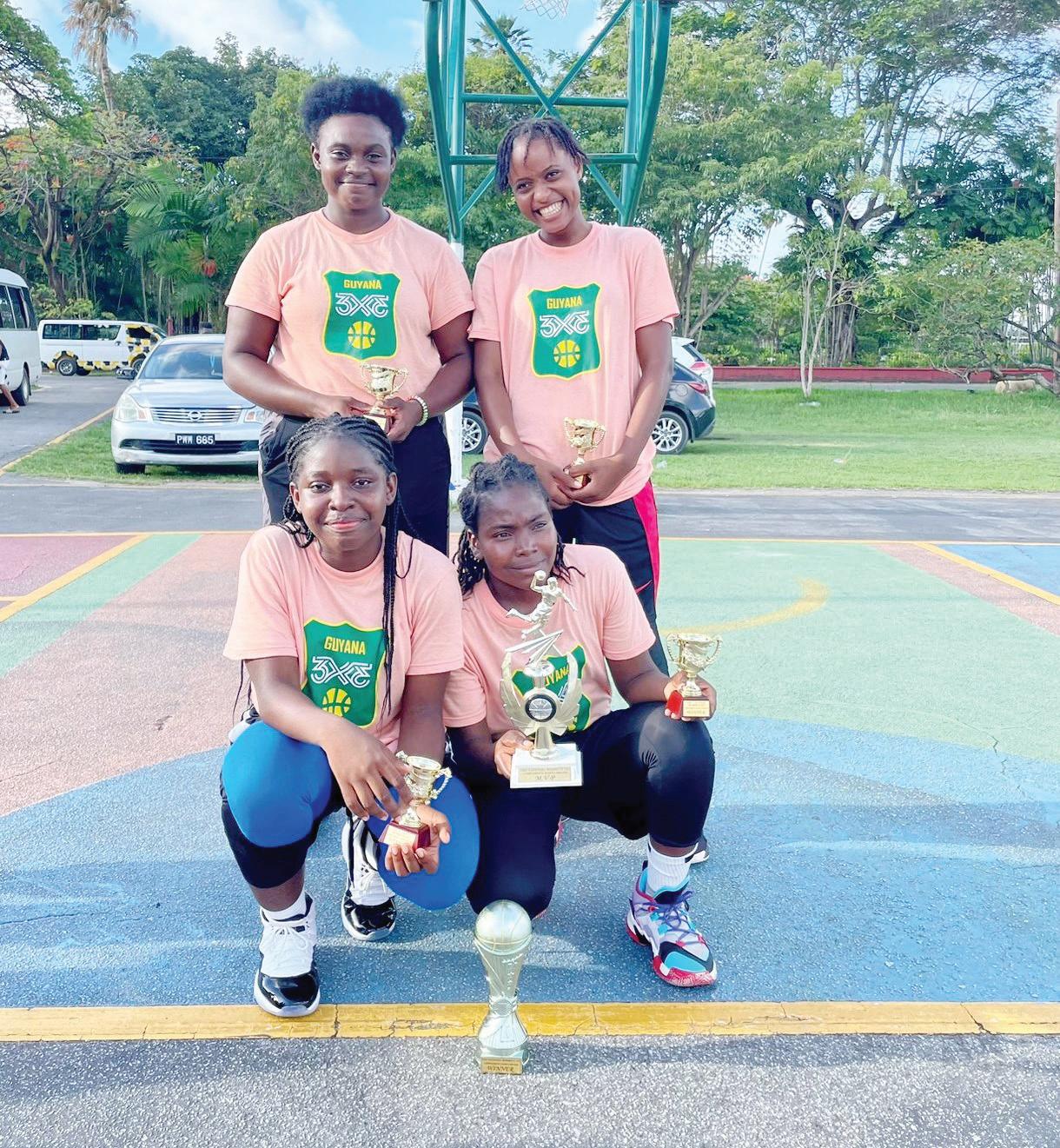
Participating teams included two teams from Kwakwani Untouchables, two teams from President's College, the UG Trojans, and the Linden Raiders. The winner was determined using a round-robin format.
Former national women's team captain Karen Abrams donated trophies for the teams to compete for, and local transportation, lifting, and logistic services provider W. Rambaran Services Inc. offered support.
The one-day tournament also served as a platform for team selection and preparation, as Guyana's women's
team qualified to compete in the Central American and Caribbean (CAC) Games in El Salvador from June 23 to
struggled against the Linden Raiders team, with the game going into overtime.
Kassidy Woolford of
year's FIBA 3x3 AmeriCup in Miami, demonstrated her superiority by scoring the two points required to secure Kwakwani Untouchables' victory.
In the meantime, the second team from the Upper Berbice Rive r community in Region 10 suffered only one loss, which came against the tournament's ultimate winners. The quartet that made up Kwakwani Untouchables' second unit - Sherel Leacock, Rihanna Archer, Brianna Benjamin, and Lenasha Mohamedalso had a strong showing in the tournament, finishing second overall.
Kirsty Thomas, a national football player from Bartica, joined Woolford, Demelza Nicholas, and Rehaicia Romain in suiting up for the Linden Raiders.
Kwakwani and Linden but earning victories against President College.
GBF president Michael Singh expressed his gratitude to the players
for a thrilling day of 3x3 basketball, pledging on behalf of the Federation to place greater emphasis on female participation in the sport locally.
July 8.
Kwakwani Untouchables
(A) team, in addition to Leacock, consisted of Shania Sears, Natalya Clarke, and Malia Samuels, and only
Linden, who hit a two-point shot at the buzzer to tie the score at nine points, sent the game into overtime. Nonetheless, Leacock, who represented Guyana at last
The University of Guyana Trojans, composed of Jamaicy Ogle, Norissa King, Shanill James, and Keisha Copperfield, won two of their five games, losing to both teams from
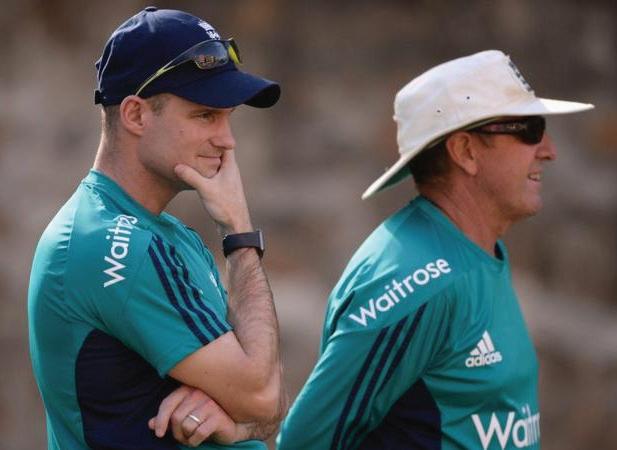
SIR Andrew Strauss will stand down as a strategic adviser to the England and Wales Cricket Board and as chair of the performance cricket committee in May.
Strauss led a performance review after England's 4-0 Ashes defeat in 2021.
But plans for fewer County Championship matches and dedicated windows for white-ball tournaments failed to pass.
"Having recently taken on additional external responsibilities, Andrew has decided it is time to step away from his ECB role," the ECB said.
ECB chief executive Richard Gould said in early April that the proposals put forward by the review to
alter the structure of domestic cricket "are dead in the water".
Strauss said: "I've really enjoyed my time at the ECB
and am proud of having contributed to a successful period for our England teams.
"With increasing commitments outside of the or-
ganisation, sadly I've decided it's time to step away from my current role."
Chief operating officer David Mahoney will also leave the ECB on 1 September.
The ECB was able to adopt 15 of the 17 recommendations made in the performance review, but changes to the schedule needed approval from at least 12 of the 18 counties, and fell short of that threshold.
Strauss, who was a twotime Ashes winning captain, joined the board in September 2020 and also stood in as interim managing director of England men's cricket between February and May 2022.
The 46-year-old had pre-
viously served as director of England cricket for threeand-a-half-years until resigning to care for his late wife Ruth in October 2018.
ECB chair Richard Thompson said: "Andrew has given outstanding service to English cricket over many years in a number of different roles.
"I've greatly valued the advice and expertise he has provided in my time as chair, and have enjoyed working with him.
"We are currently implementing the vast majority of recommendations from his impressive high performance review, which I believe will help our England men's teams to sustain their success.
"I have no doubt he has much more to contribute to the game and hope he will return in the future."
Penny Avis, Baroness Zahida Manzoor, Jennifer Owen Adams and Gareth Williams have all been appointed as non-executive directors.
The three-year appointments follow the death of Brenda Trenowden and the departures of Barry O'Brien, Jim Wood, Lucy Pearson, Valerie Amos and Martin Darlow.
The appointments will be ratified at May's annual general meeting. Two further appointments will be made "in due course", the ECB said.(BBC Sport).

Guyana Football Federation (GFF) Elite League Season Five will kick off on Saturday, May 13 with ten FIFA licensed football clubs competing to win a total of $4 million in cash prizes.
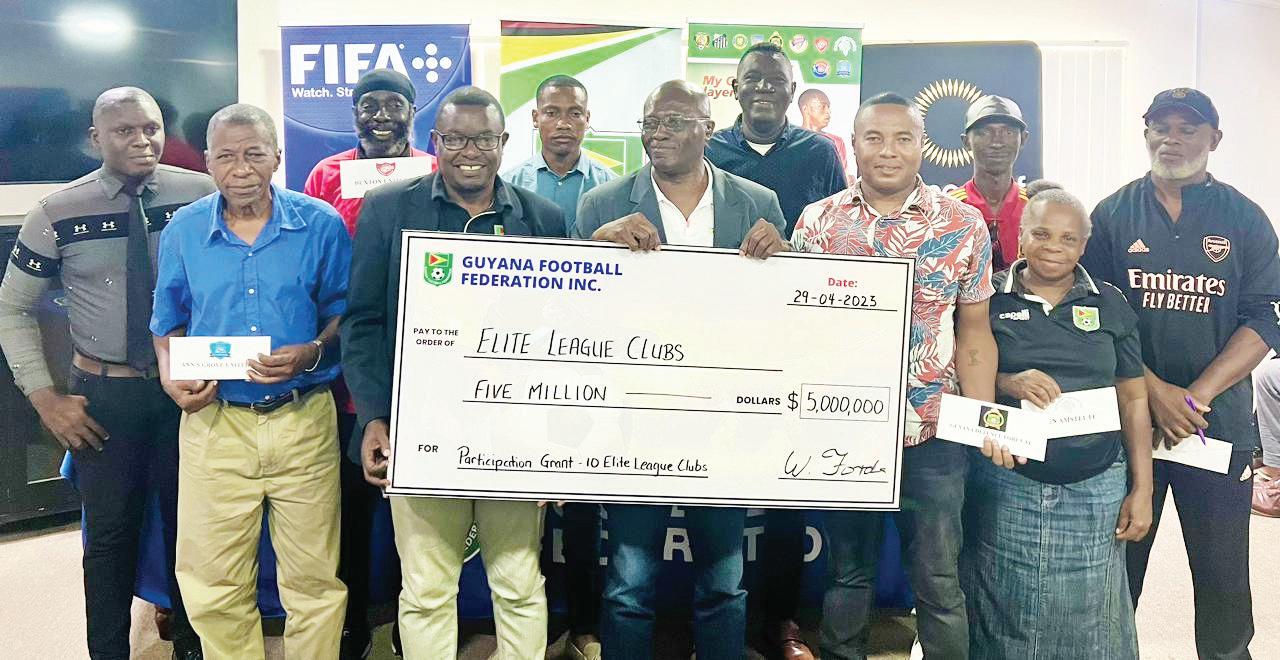
The 2023 league was officially launched at the GFF Headquarters in Georgetown on Saturday last.
The premier men’s football competition will run from May 13 to the end of July and will feature the reigning champions Fruta Conquerors, Guyana Defence Force Football Club, Western Tigers, Den Amstel, Victoria Kings, Buxton Unit-
ed Sports Club, Milerock Football Club, Ann's Grove Football Club, Guyana Police Force Football Club and Santos Football Club.
GFF President Wayne Forde said players participating in the two-month league, which will be broadcast on the FIFA+ platform, will benefit tremendously from global exposure.
“We are happy to kick off season five of the Elite League and look forward to some exciting matches in the coming weeks. Our players will benefit tremendously from the global exposure they will enjoy through the FIFA+ live streaming plat-
`No other franchise or even my country never really invest that much on me.’
ANDRE Russell has thrown Cricket West Indies (CWI) under the bus in a recent interview claiming his Indian Premier League franchise Kolkata Knight Riders treats him better.

The 35-year-old all-rounder has played for KKR since 2014, when he helped them win the IPL title.
Since that time, Russell, who last played for the West Indies during the ICC T20 World Cup in 2021, has declined several opportunities to represent the regional team often citing health issues relating to long-term knee injuries.
During a recent interview on Star Sports in India, Russell said KKR makes him feel special for everything that Kolkata-based
franchise did for him to get treatment done on his knees.
"Where I was, a few years
ago, KKR actually make things happen for me where they send me to get proper treatments on my knees,” Russell said.
“That's something special to me to be honest. No other franchise or even my country never really invest that much on me."
Russell added that he feels at home at KKR.
"I'm happy here. I don't see any other franchise I would love to be a part of in this tournament because I've been here for about nine years now. Been here for so many years, I meet these guys, get closer to them every year," he said. (Sportsmax)
form. My hope is that this exposure will create new opportunities for these young men to access international professional contracts''.
The winner of the league will automatically qualify for the CONCACAF / Caribbean Shield Championships.
The national tournament was suspended in 2020 due to the Covid-19 pandemic. It returns this year with Guyana's top clubs vying to be champions.
Teams will play several rounds of football with the two clubs scoring the most points advancing to the two-million dollars championship match.
Tim David had been searching for one of his finishing hurricanes for some time in the Indian Premier League - and when the storm finally arrived in Mumbai, it simply blew Rajasthan Royals away.
In another IPL finish which once seemed incredible but now passes almost as workaday, David was asked to hit 17 off the last over to give Mumbai Indians victory over the Royals on Sunday.
Instead, it took the Australian big hitter just three balls.
He walloped six, six, six to power the home side to a devilishly difficult six-wicket win - but perhaps a fittingly dramatic end to the league's landmark 1000th game.
All three came off calamitous full tosses from former West Indian captain Jason Holder, who appeared to be simply trying too hard to contain the Aussie international and overpitched his attempted yorkers, only to watch in despair as the 27-year-old provided the trio of knock-out punches.
Tim David had been searching for one of his finishing hurricanes for some time in the Indian Premier League - and when the storm finally arrived in Mumbai, it
simply blew Rajasthan Royals away.
In another IPL finish which once seemed incredible but now passes almost as workaday, David was asked to hit 17 off the last over to give Mumbai Indians victory over the Royals on Sunday.

Instead, it took the Australian big hitter just three balls.
"I've wanted to play an innings like this for a while," smiled David, who, before Mumbai teammate was bought for more than $3m,
was the highest-paid of all Australians when he was snapped up before the 2022 competition for $1.53m.
This was a dazzling demonstration of exactly why the Singapore-born batter, now in his second season with Mumbai, was originally deemed worth the big bucks as he provided a ruthless, clinical finish to the Indians' chase of Rajasthan's 7-212.
It was the first time that a 200-plus total has ever been successfully chased down at the Wankhede Stadium in
the IPL.
The Royals had earlier been inspired by a remarkable knock from opener Yashasvi Jaiswal, who hit 124 off 62 balls - the highest in the league this year at an average of exactly two runs per ball - featuring eight sixes.
He scored 106 more than any of his colleagues - and he even belted a short one from the fearsome Jofra Archer right out of the ground in a quite extraordinary display.
But on a belting pitch, though, it had always looked an attainable target, until David's star Australian teammate Green fell for a sparkling 44 off 26 balls - hitting a couple of huge sixes himself - and then the magical Suryakumar Yadav got dismissed for 55 off 29 balls.
When David came to the crease, 72 were still needed off 4.2 overs but, with help from Tilak Varma's 29no off 21 balls, the West Australian was in breathtaking form from the outset to chase down the unlikely win.
Off just 14 balls, he changed the course of the match with five sixes and two fours in his 45no.
"In the final over, I tried to get in front and close the angle down, play good